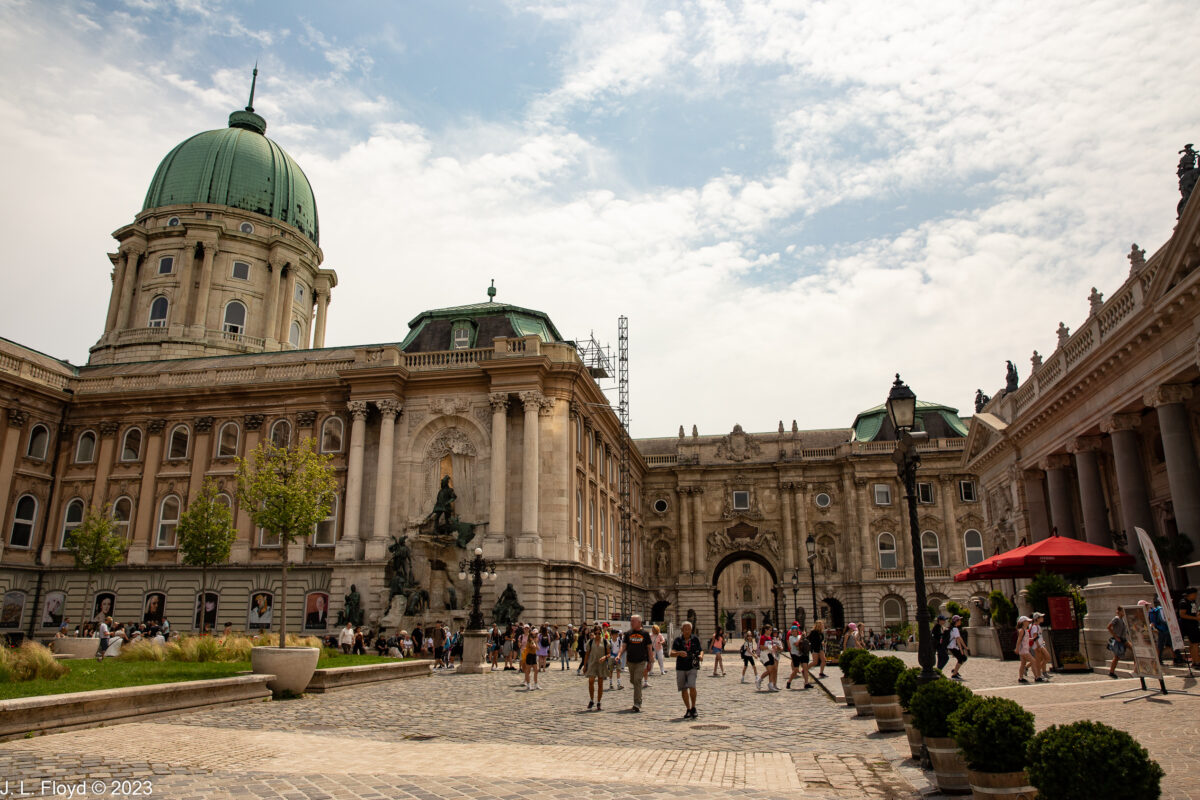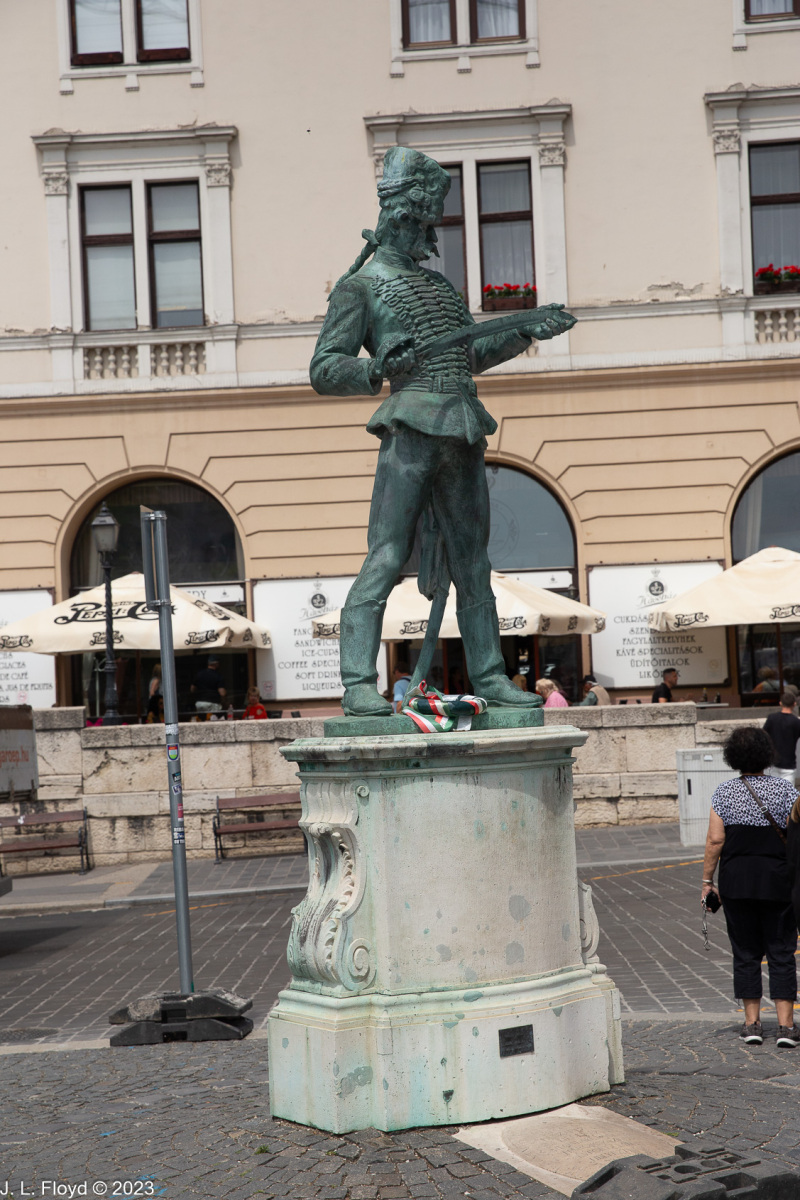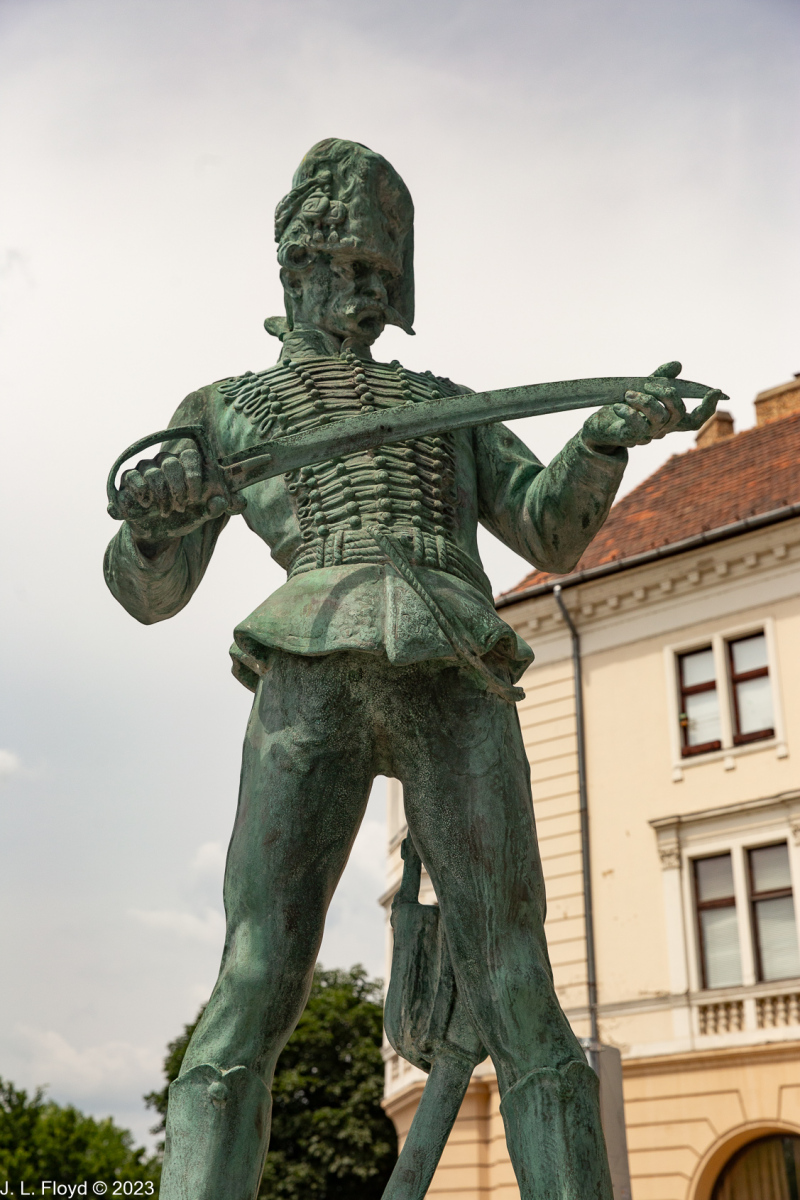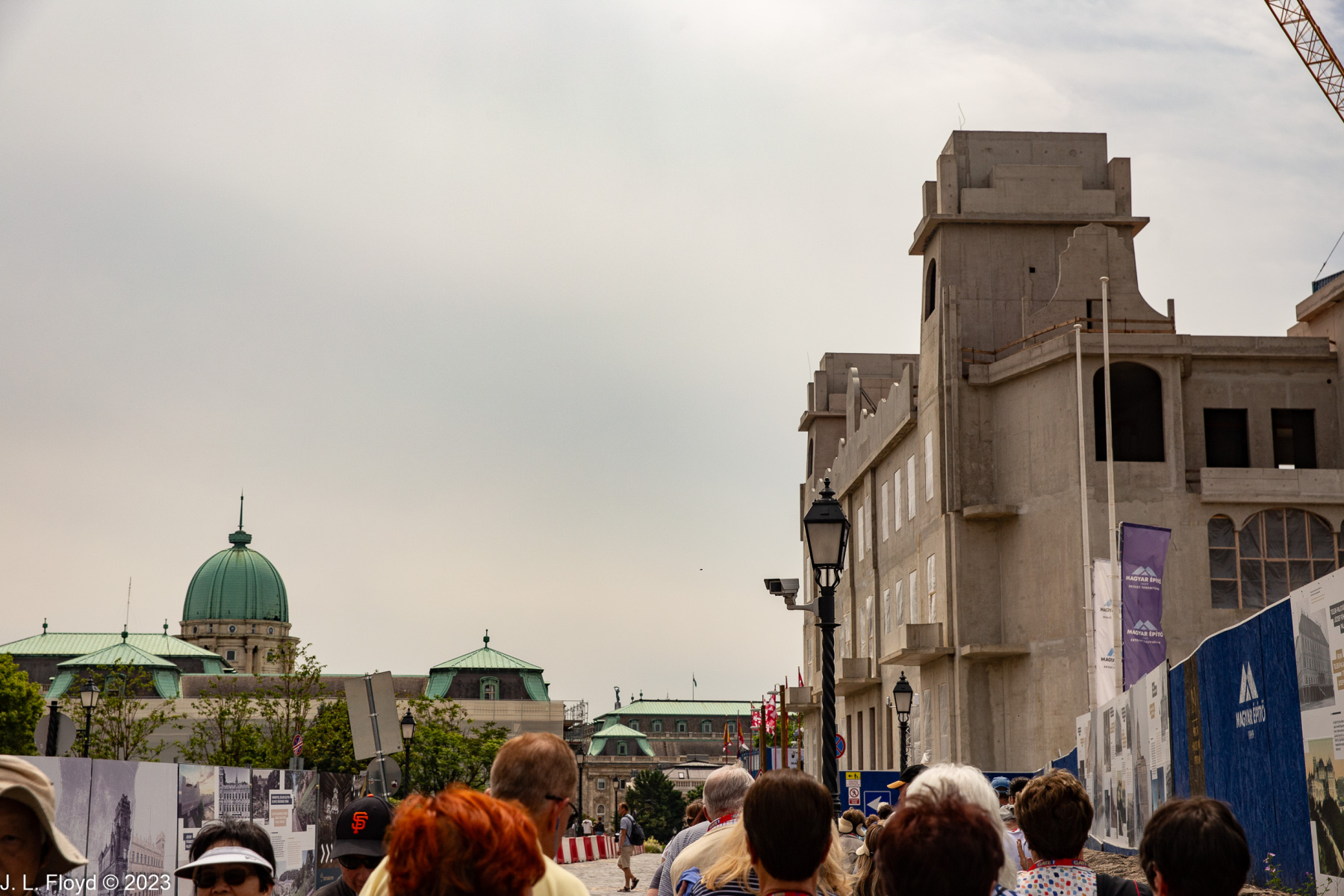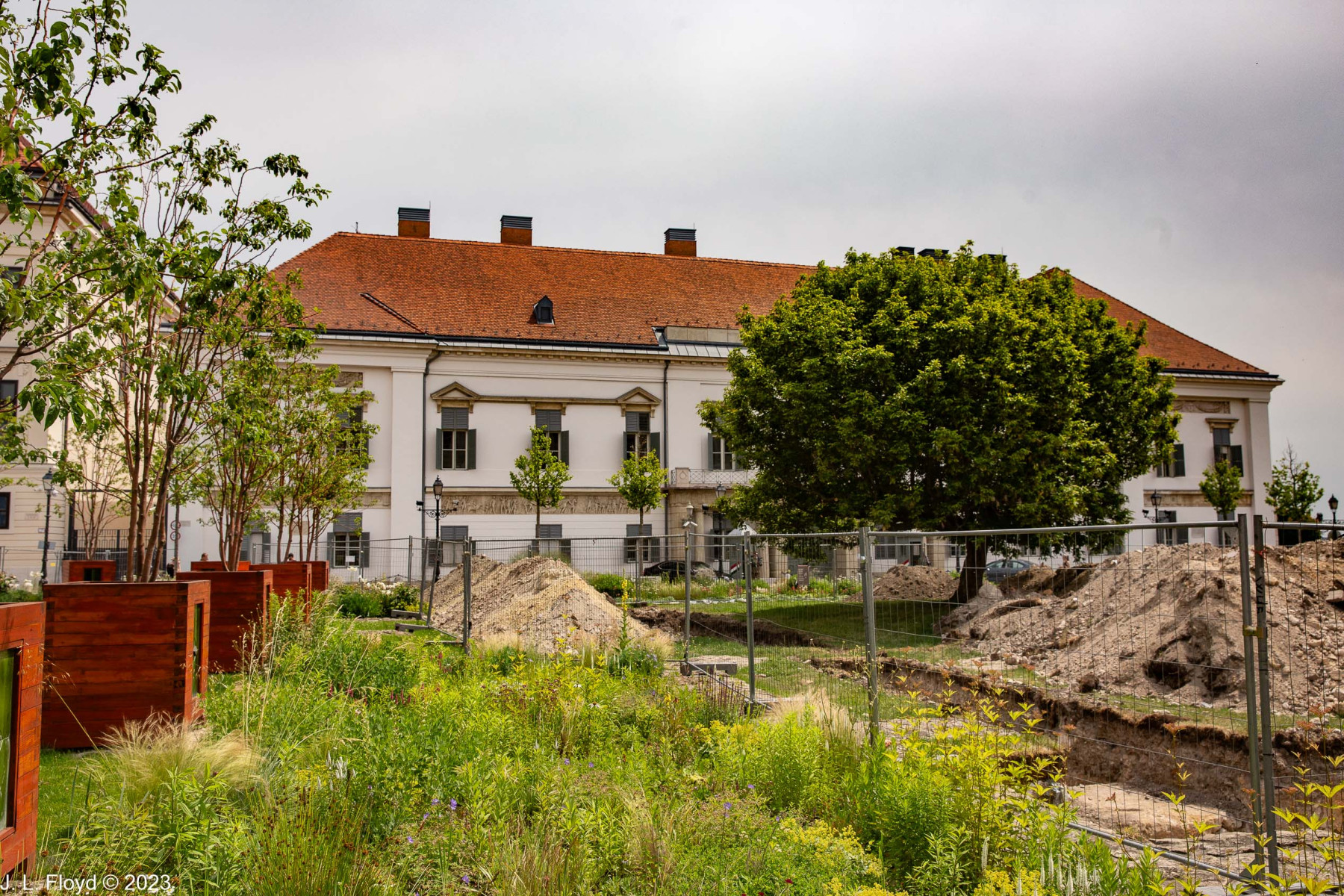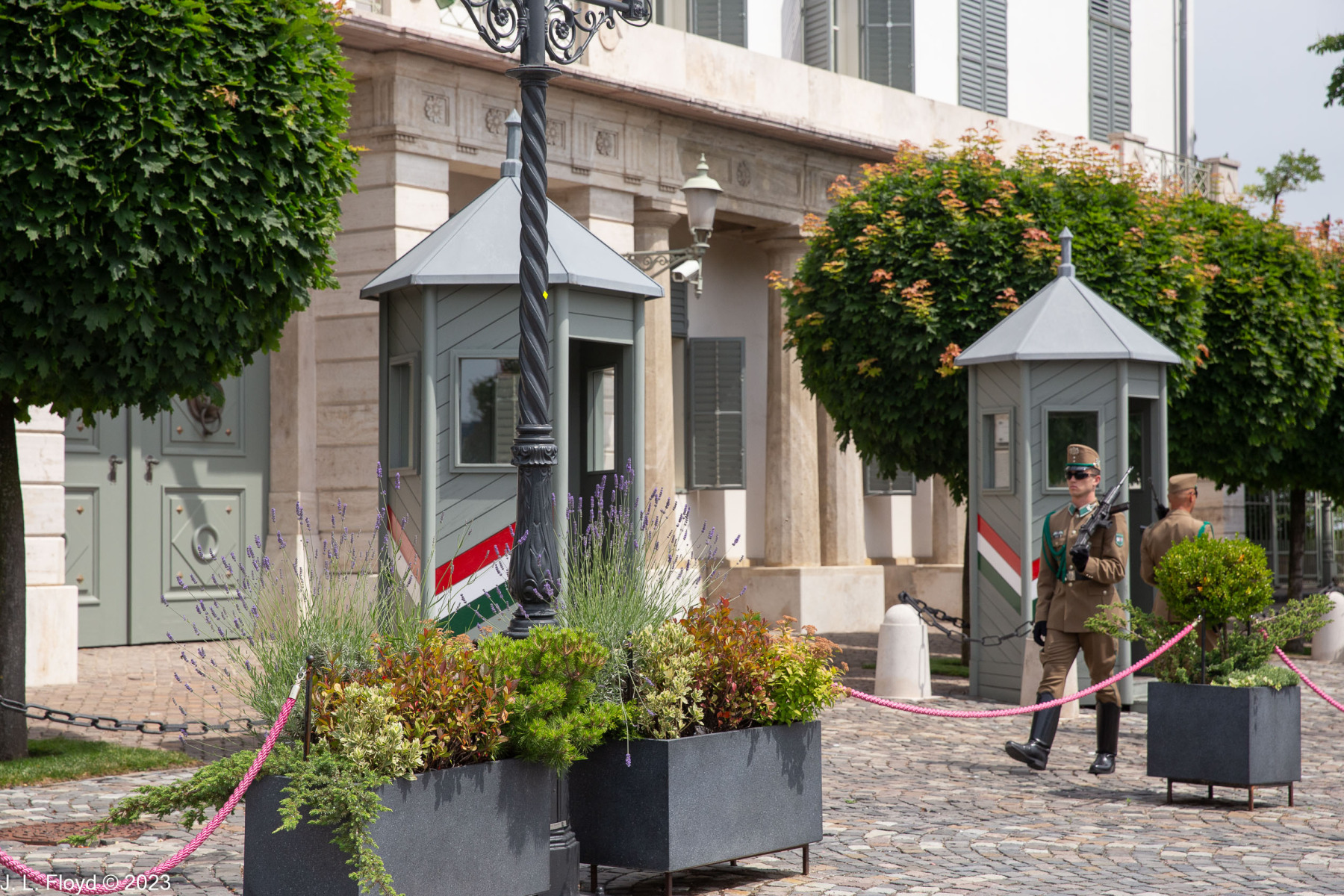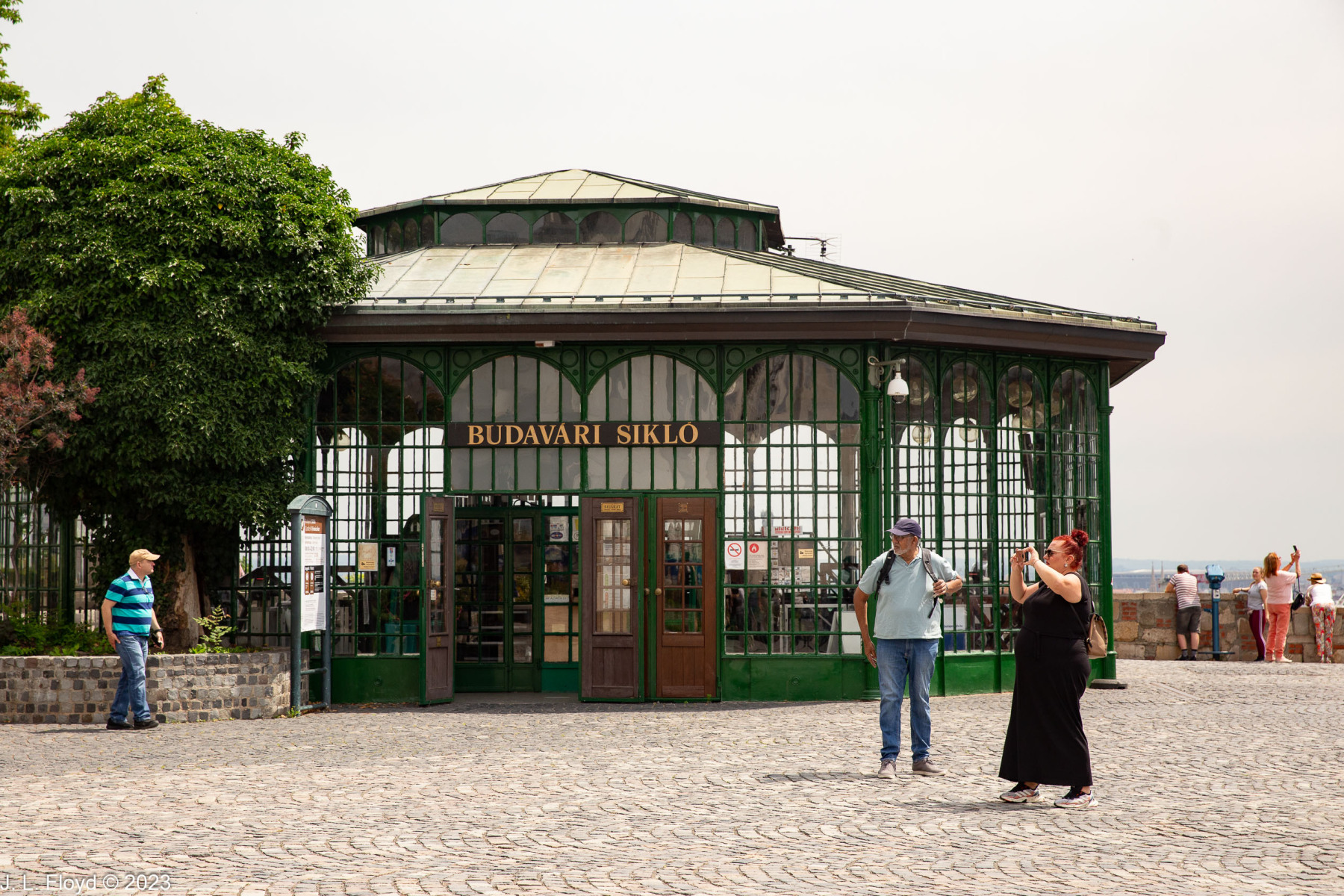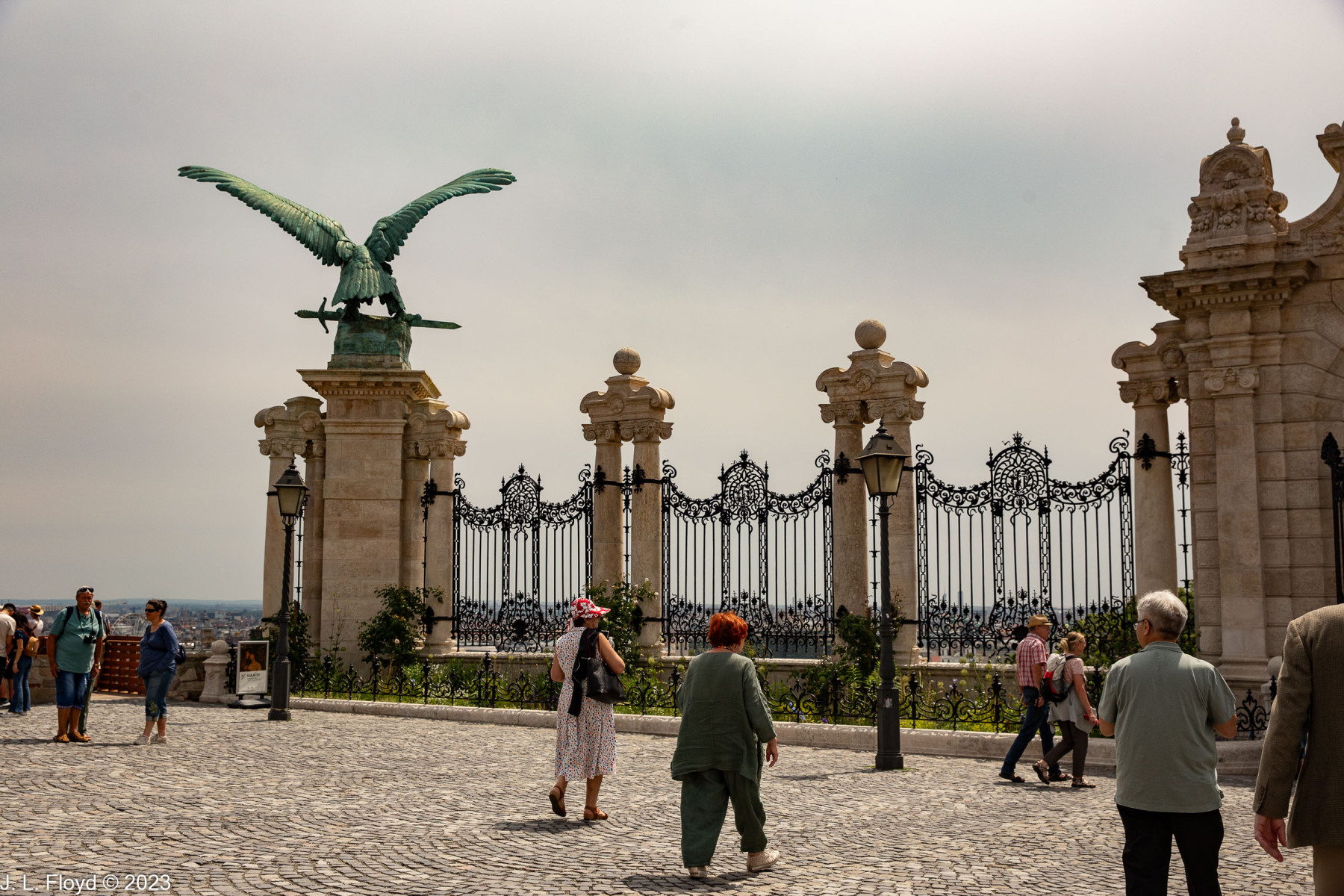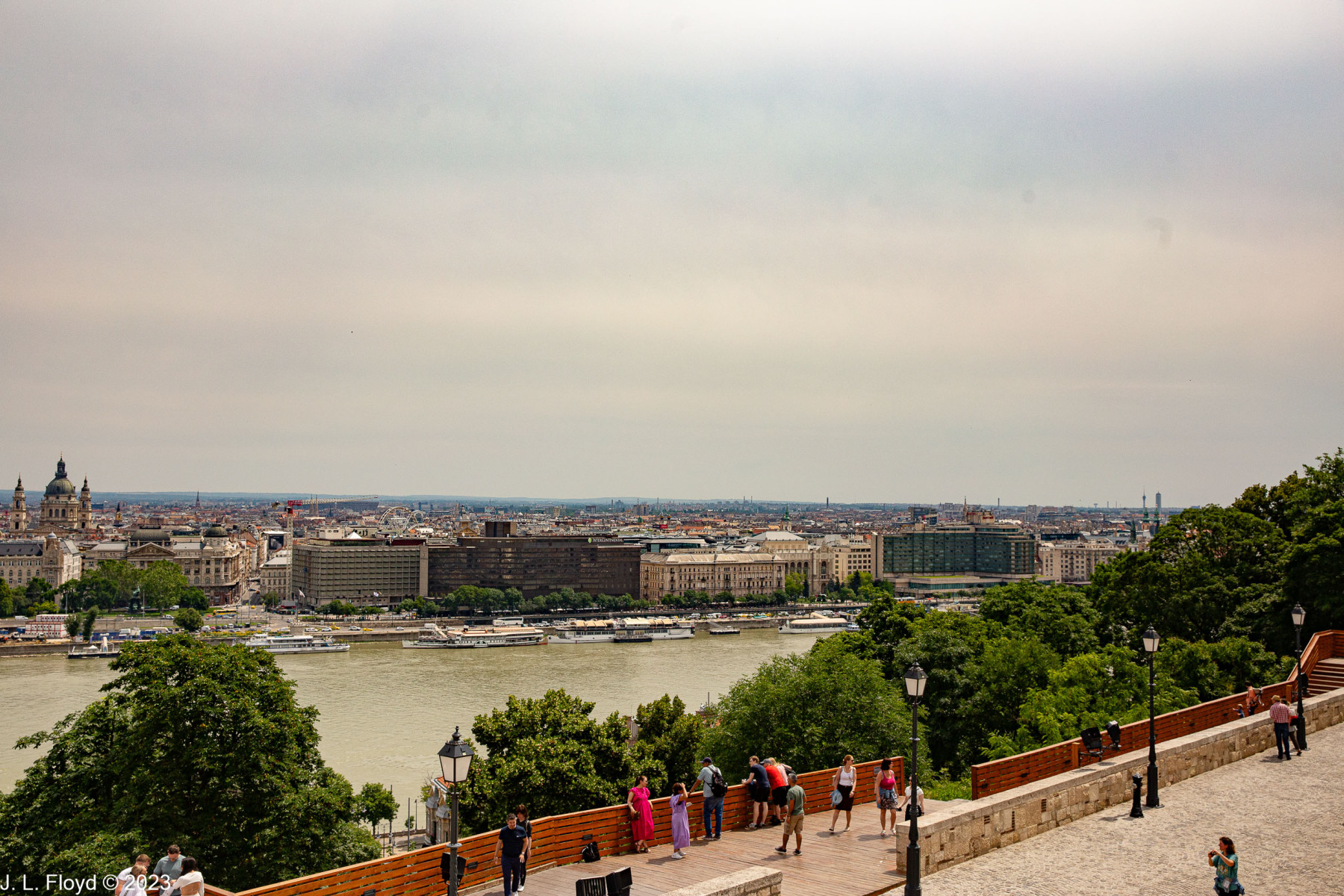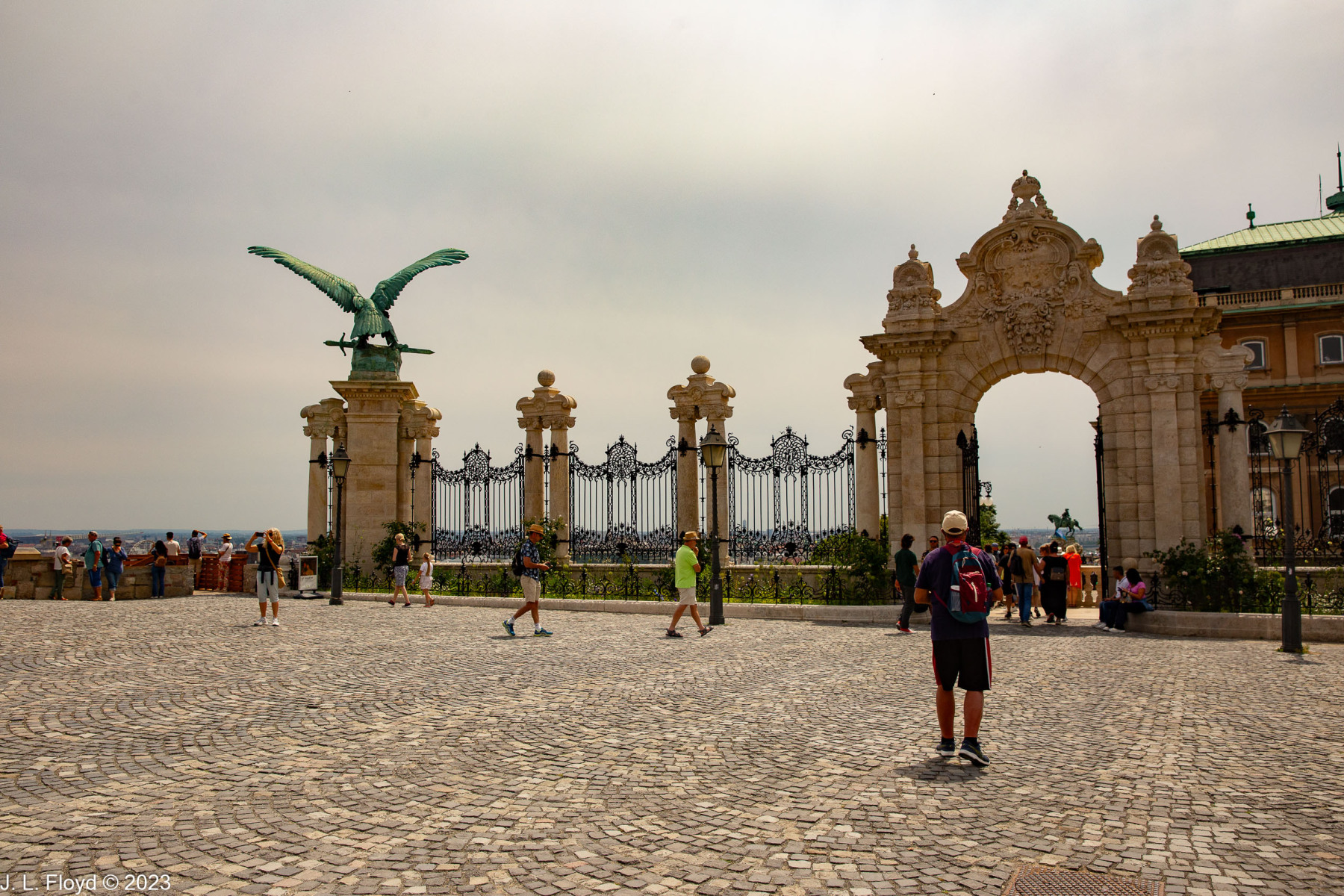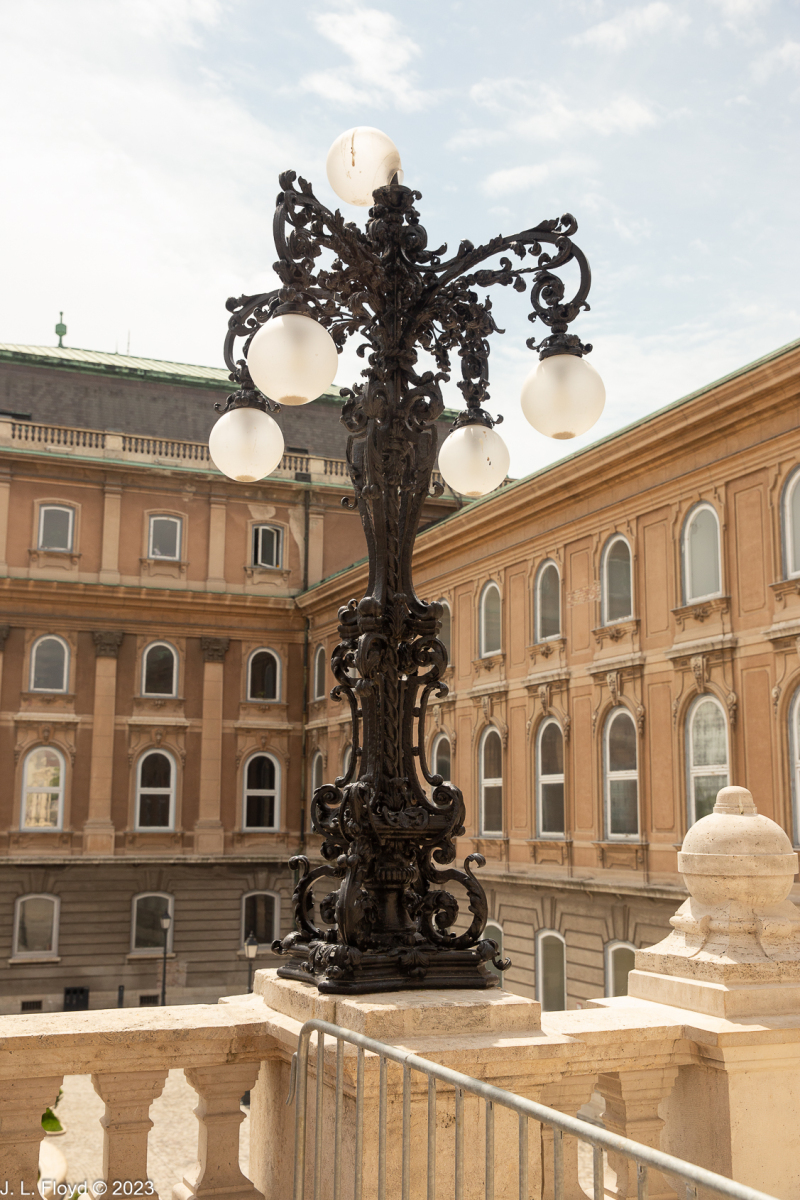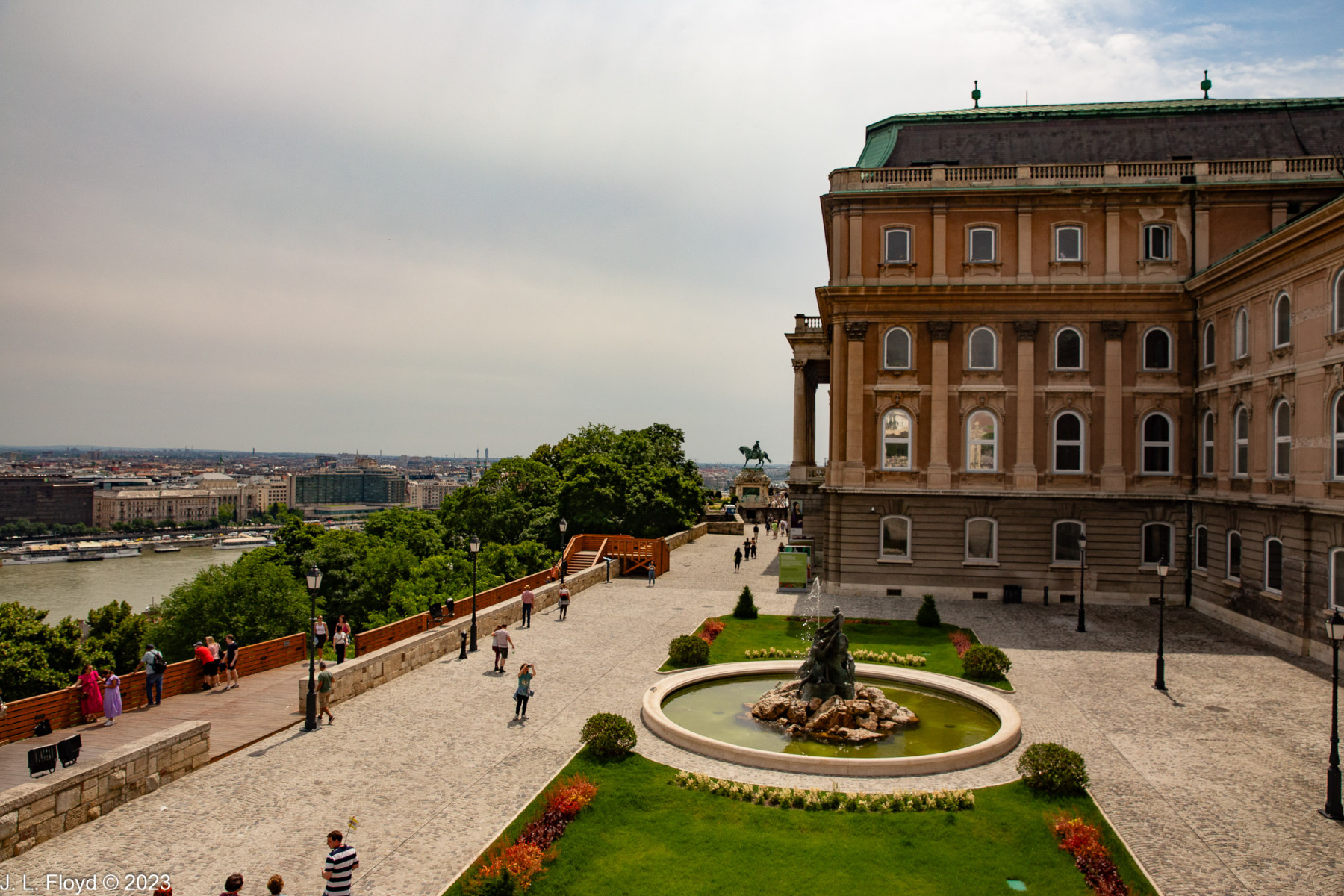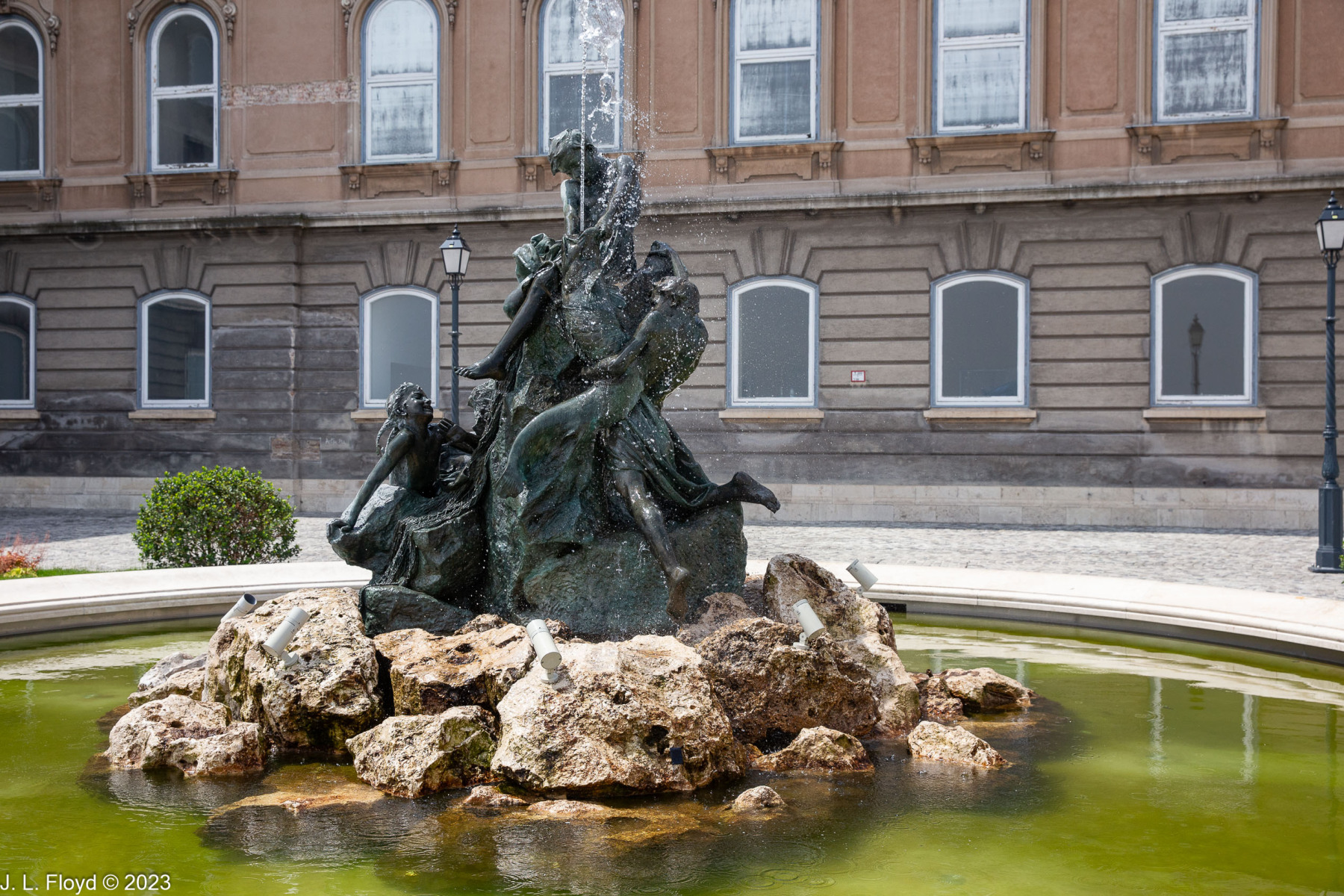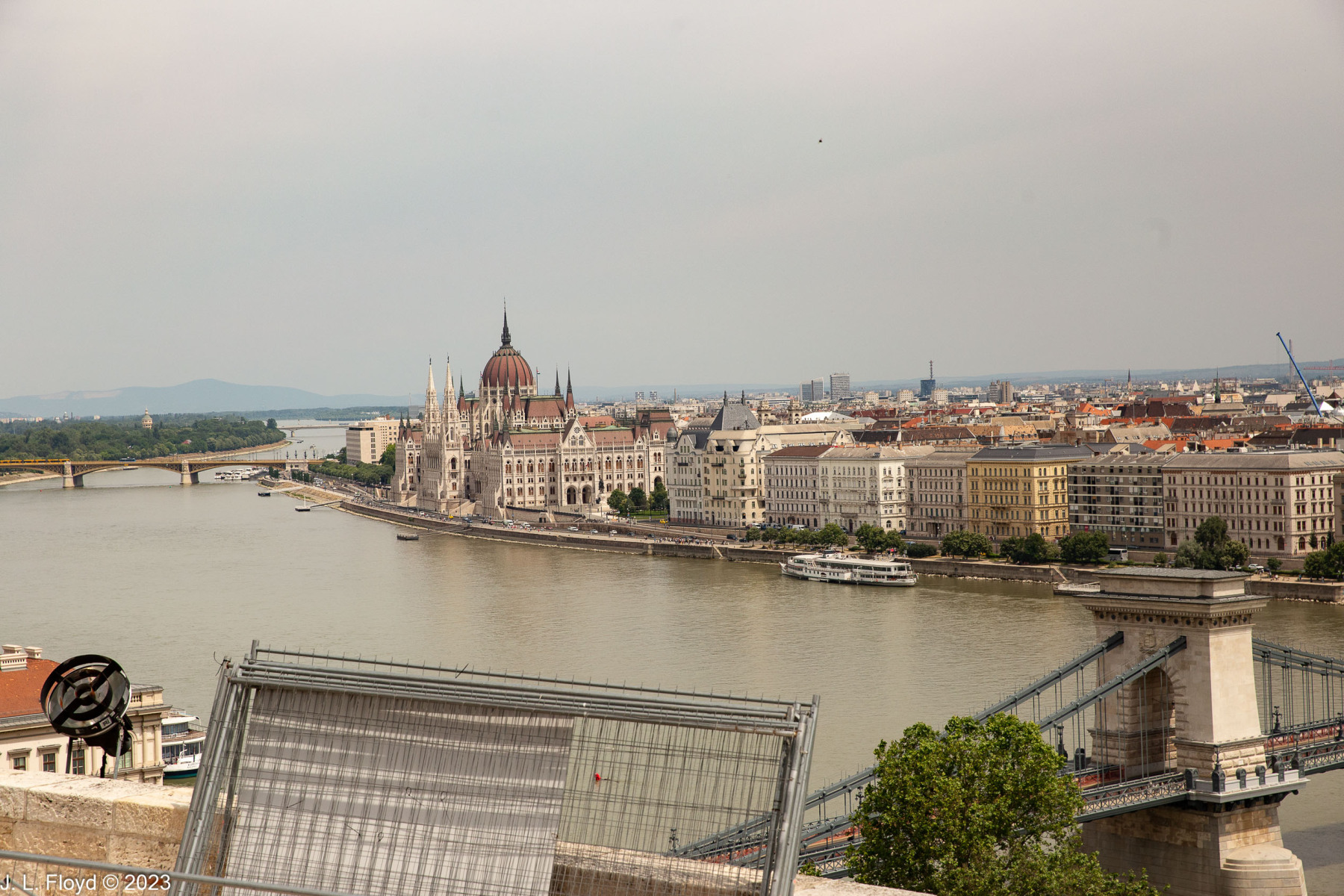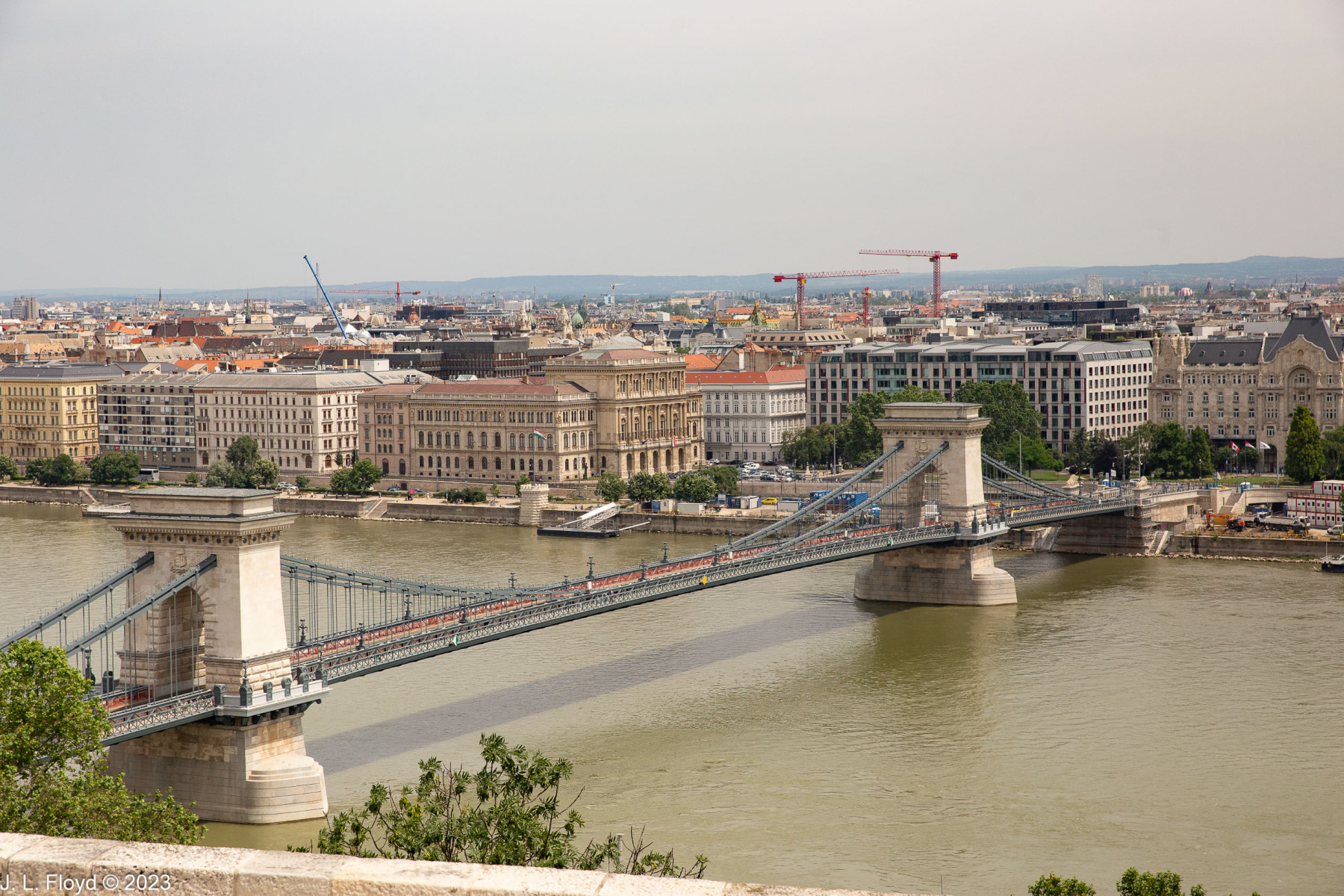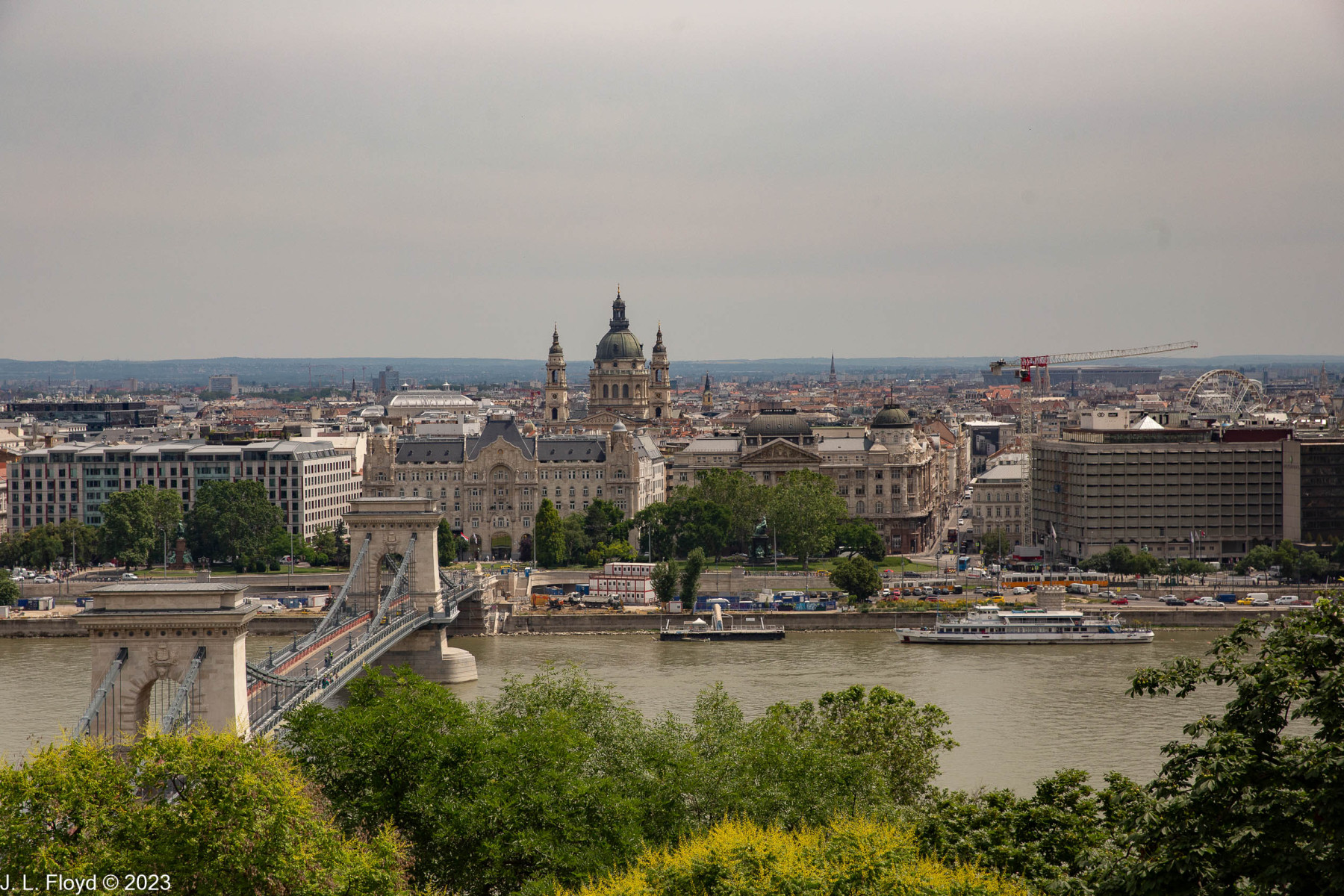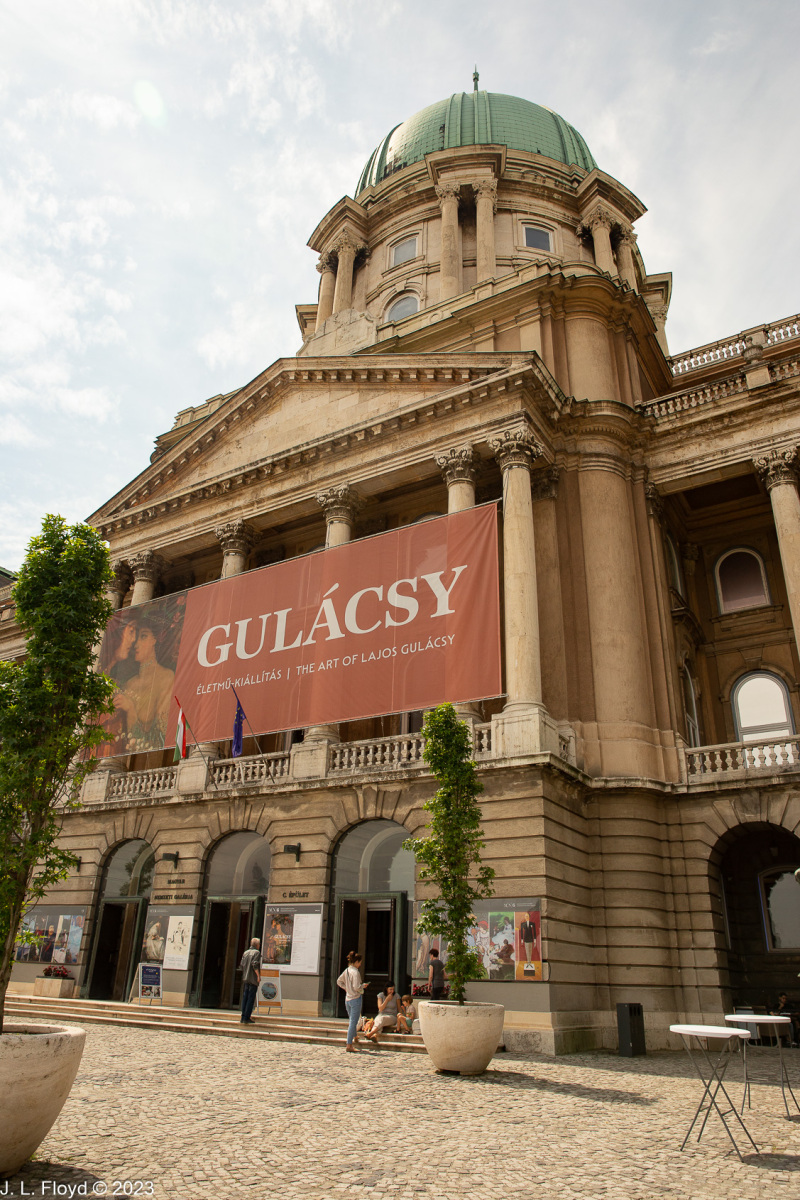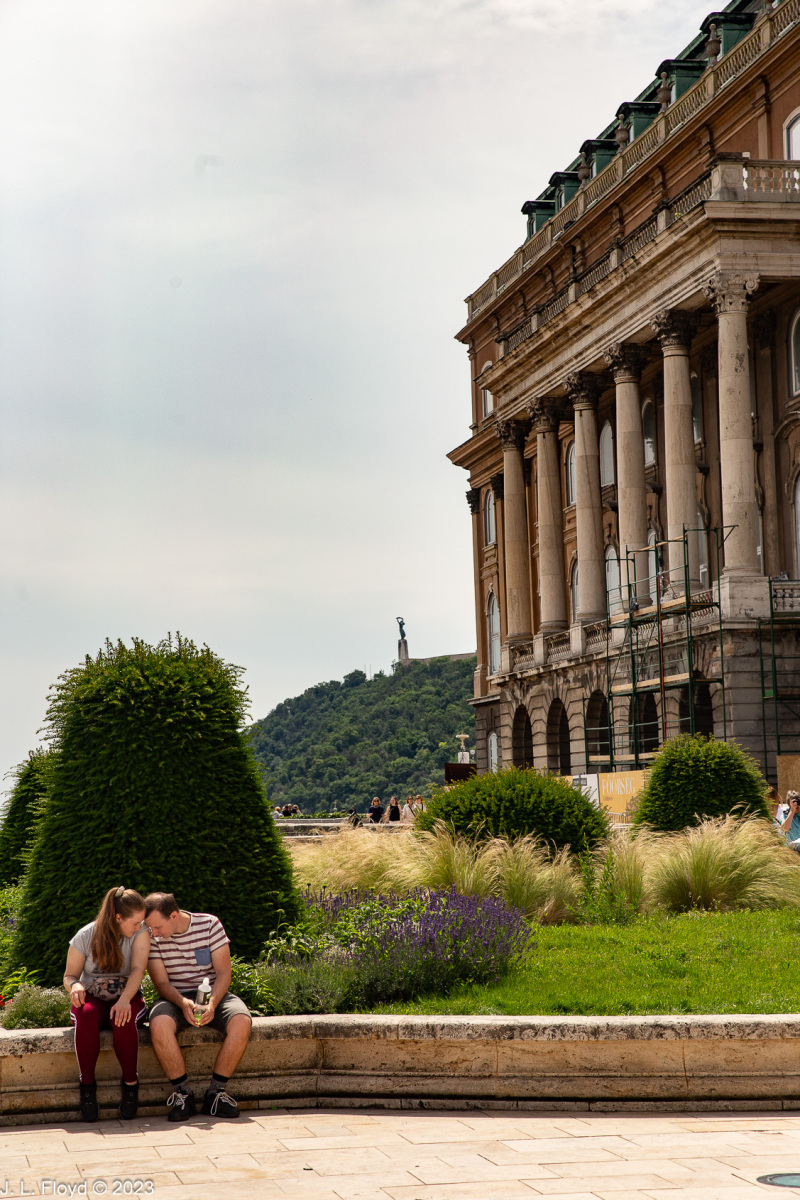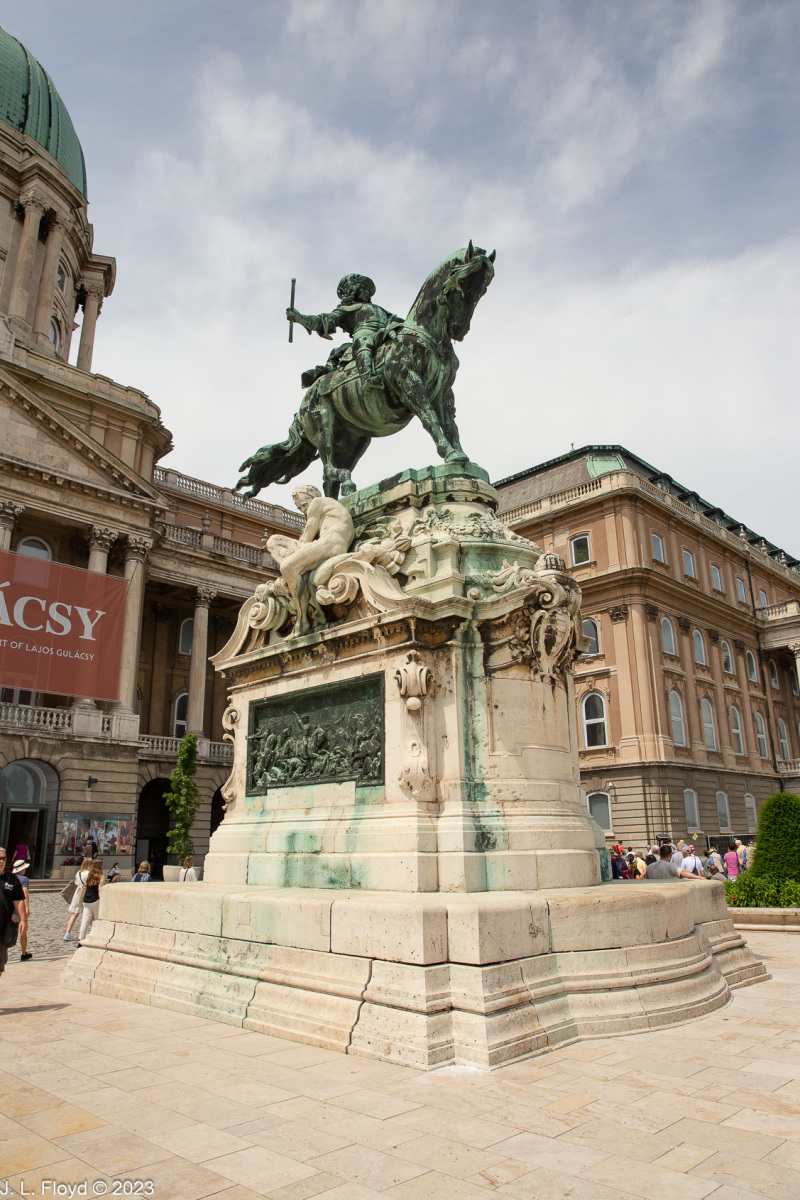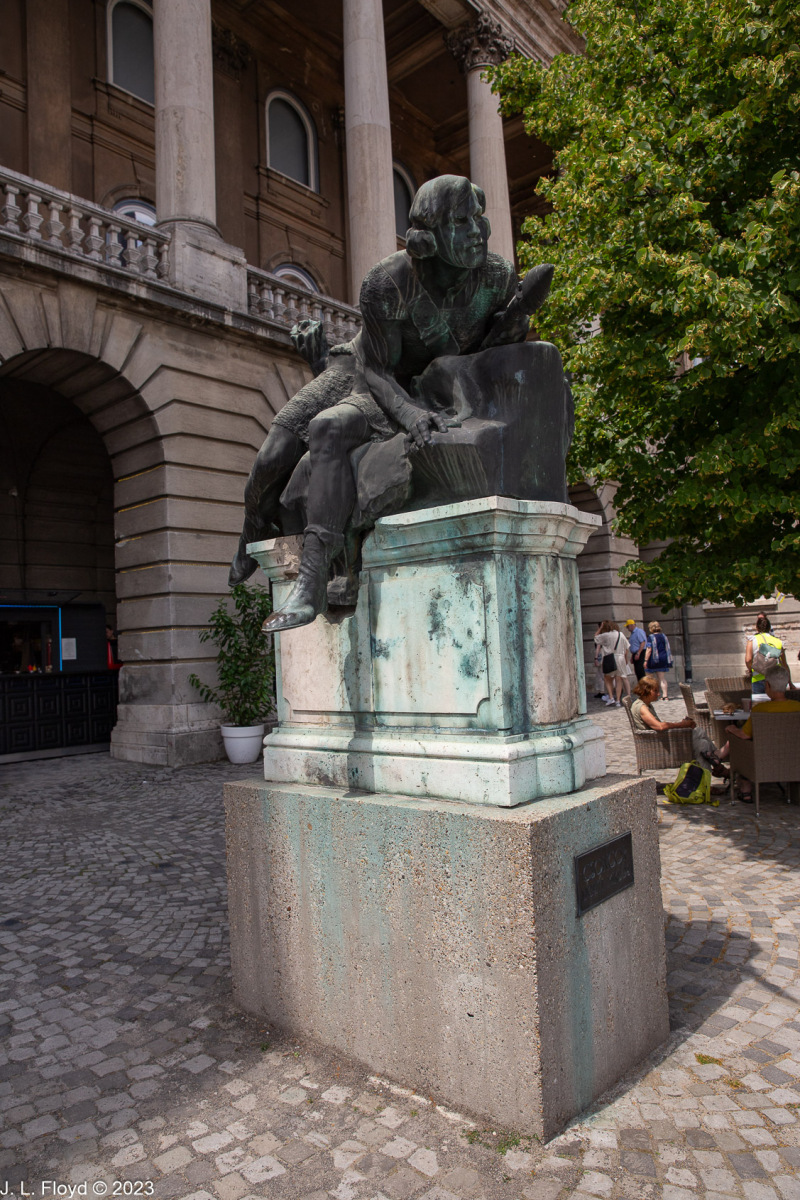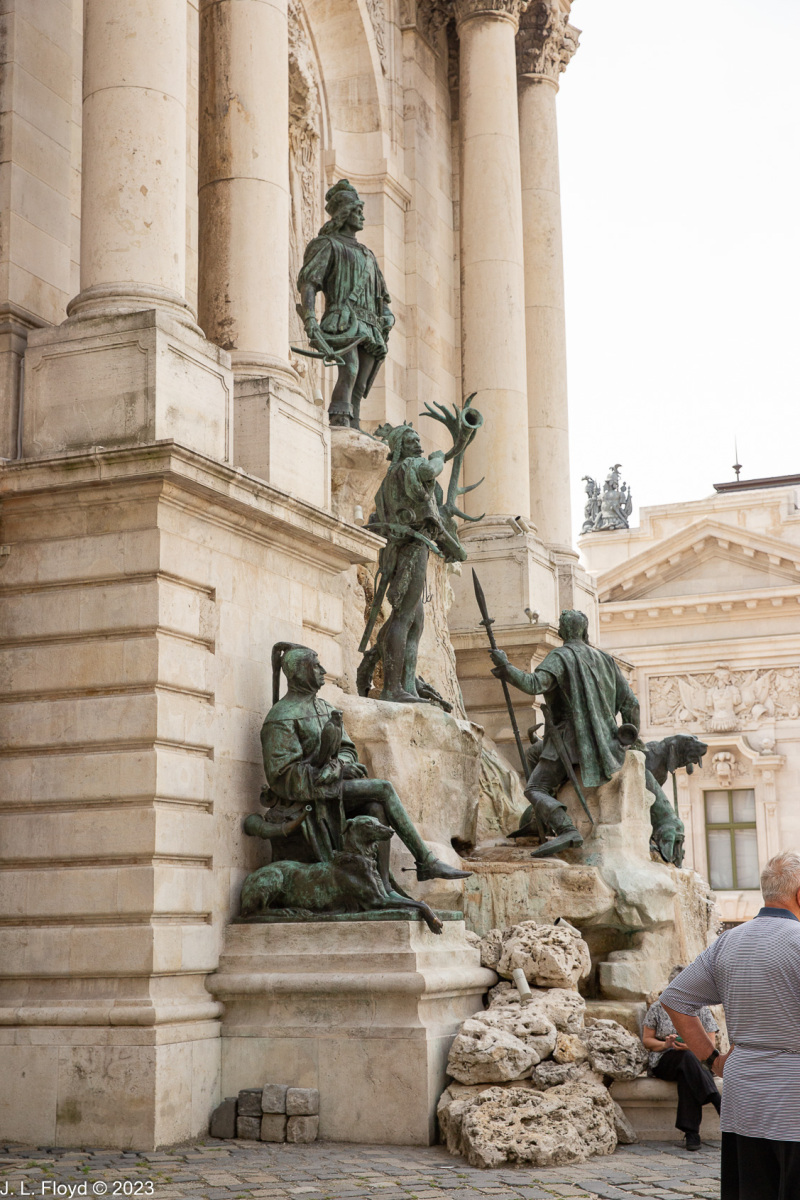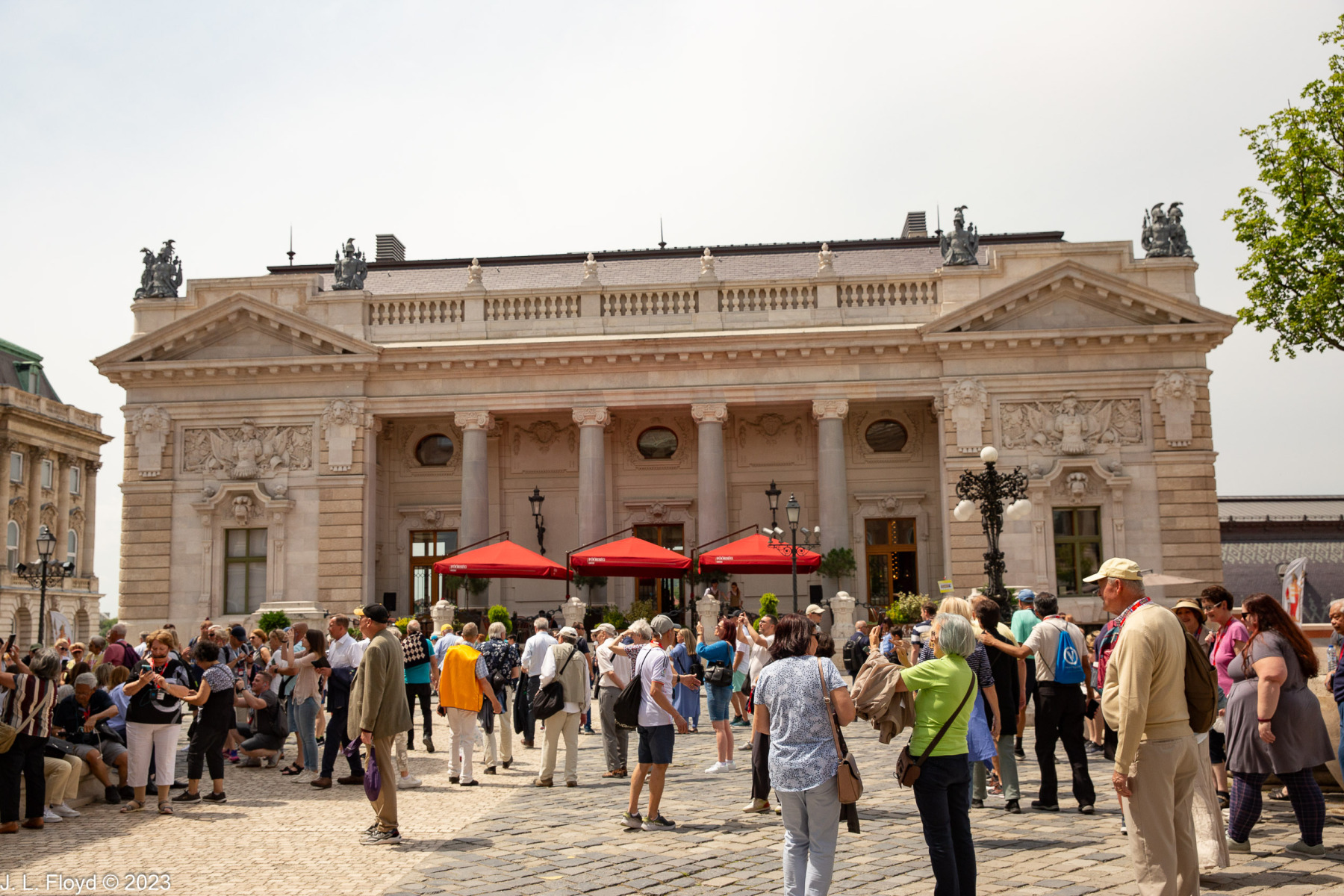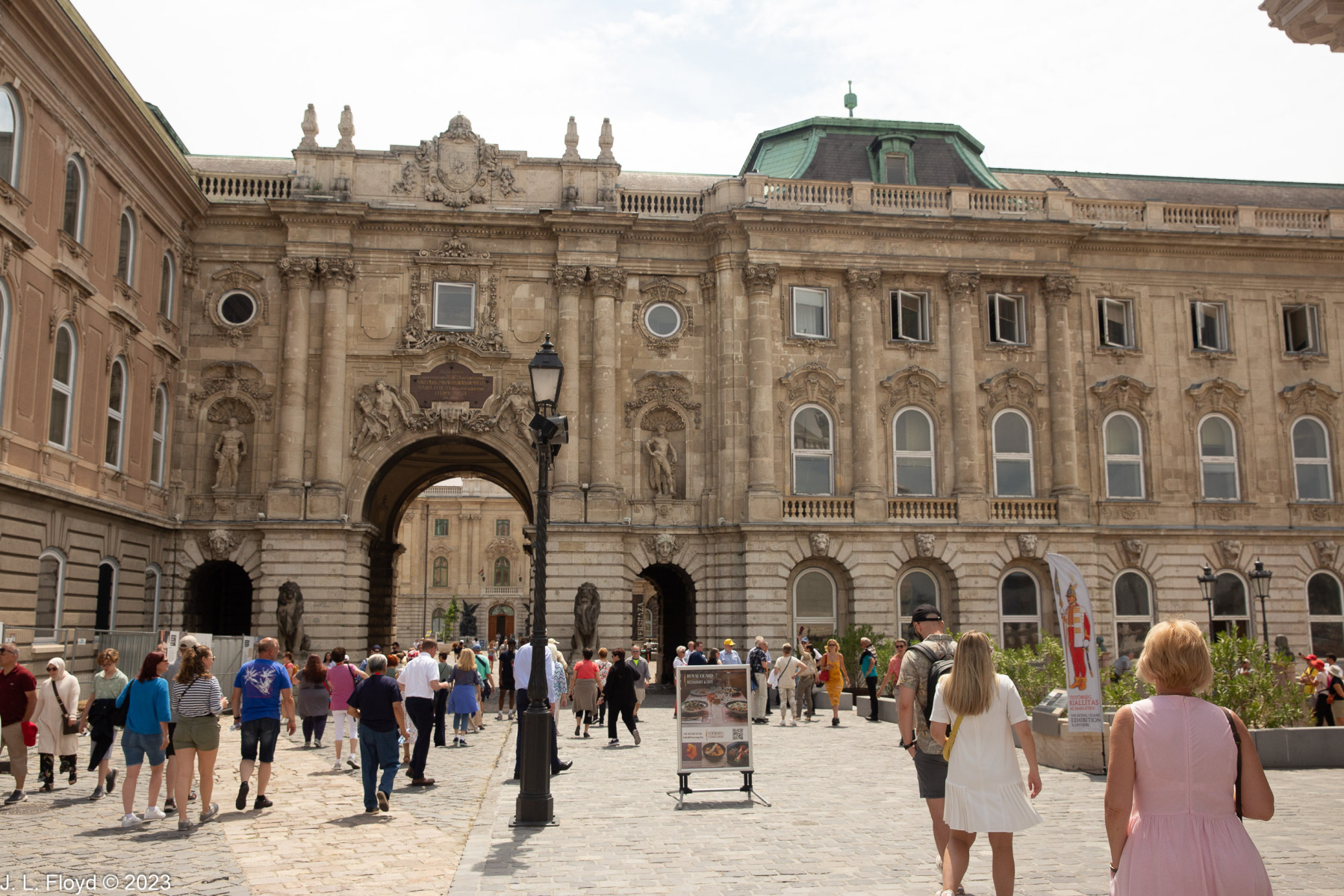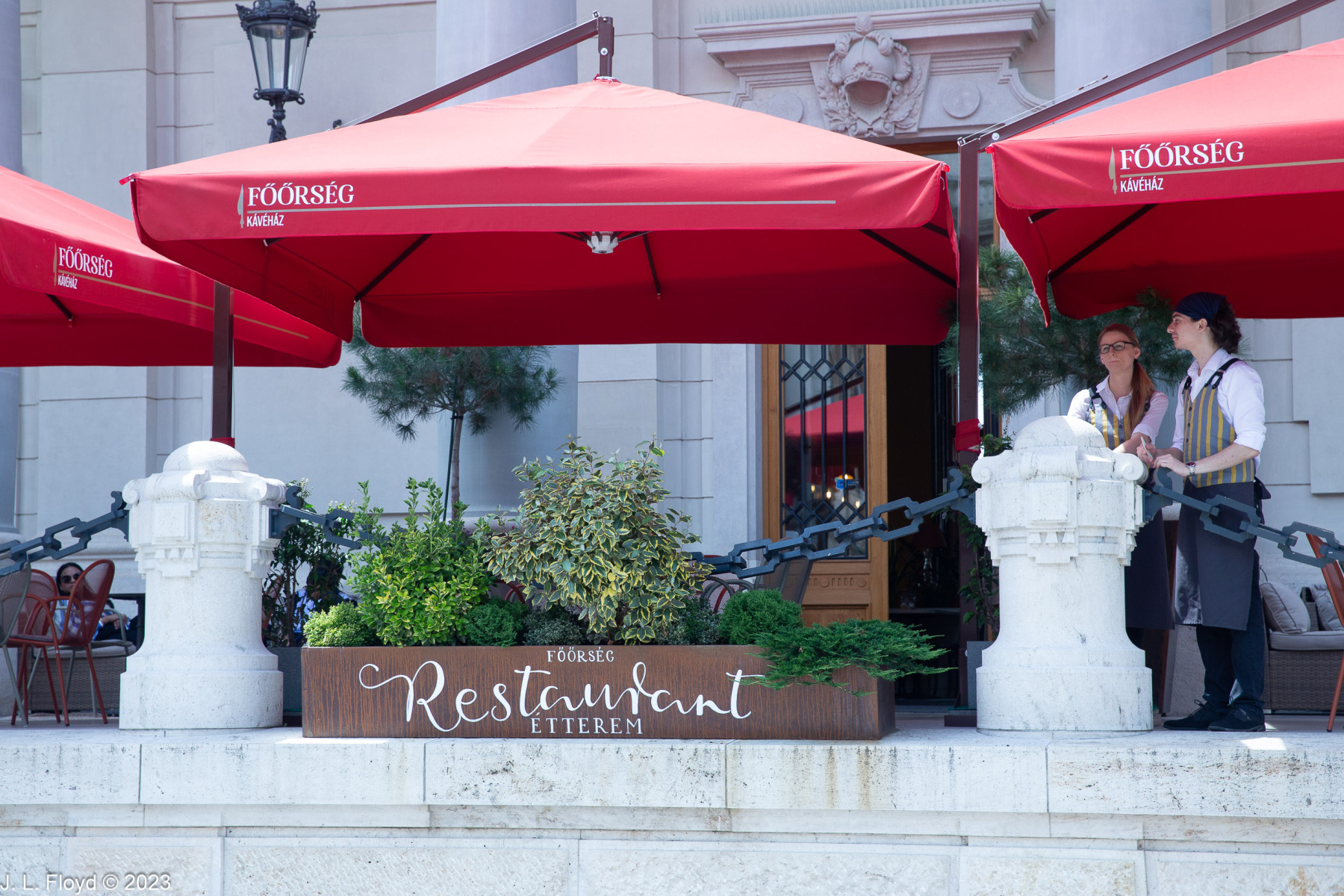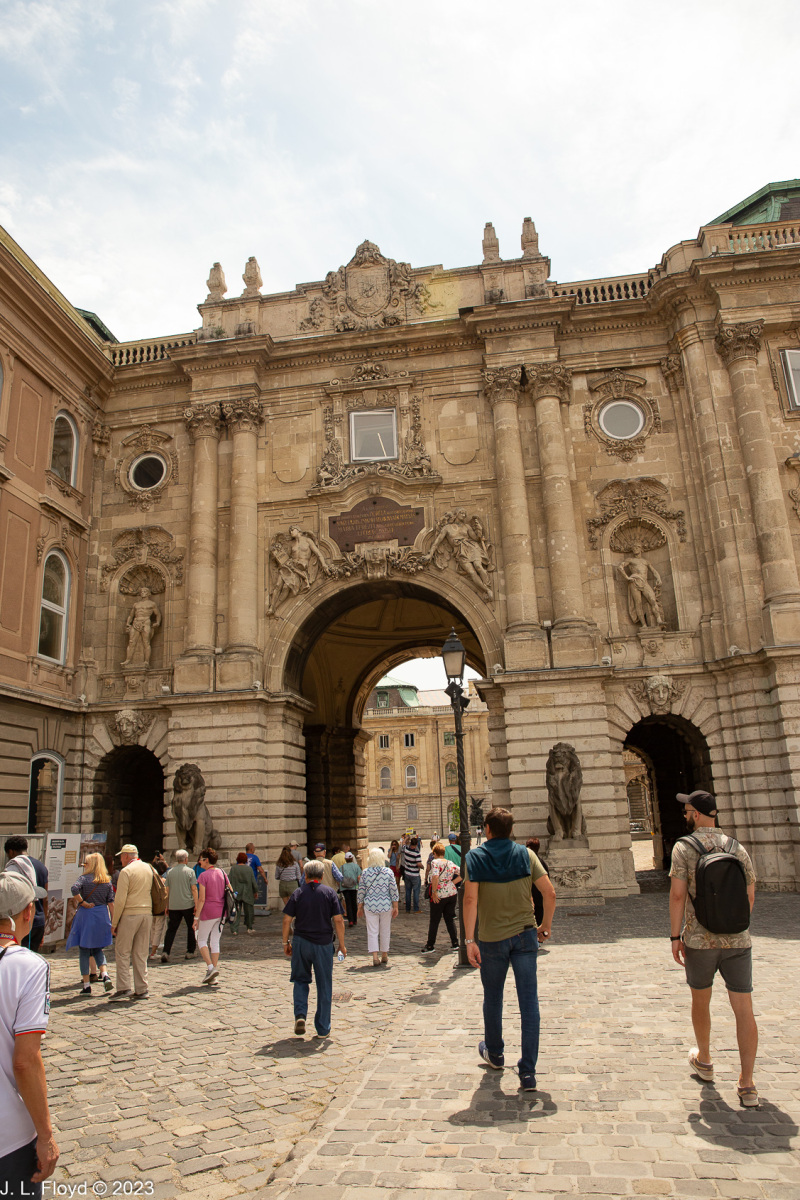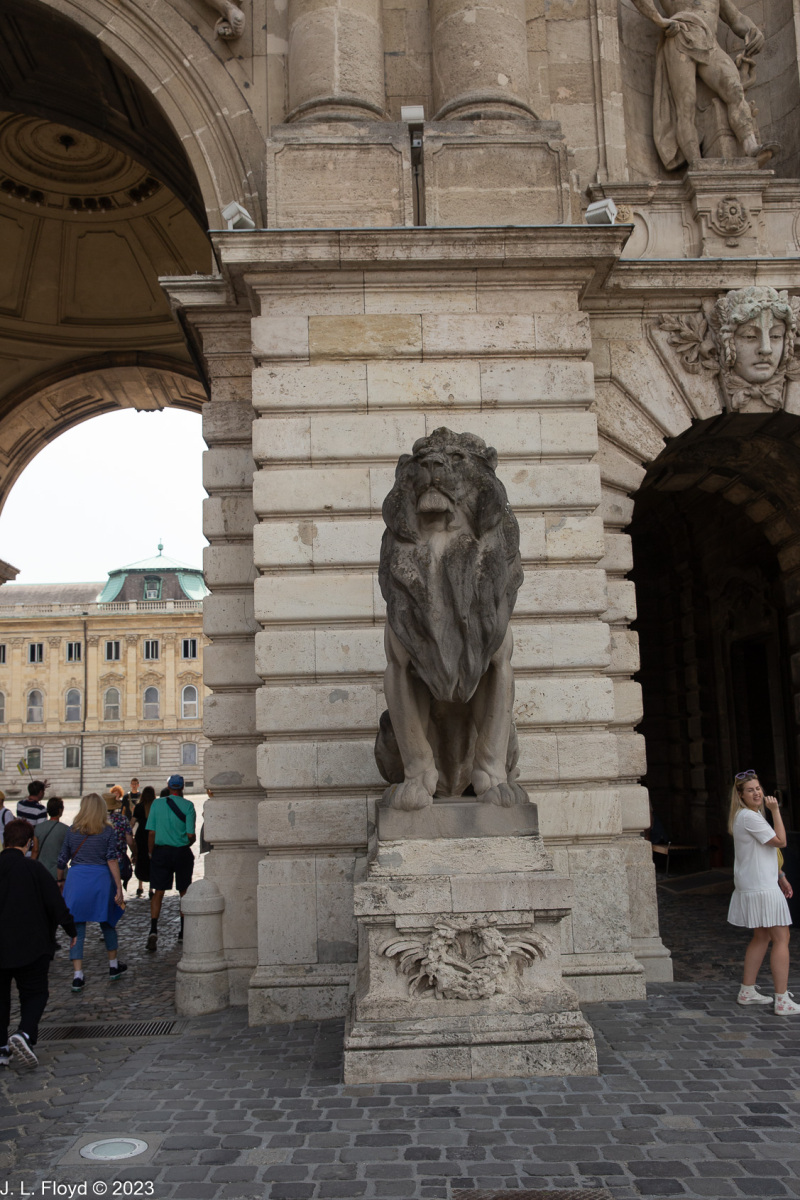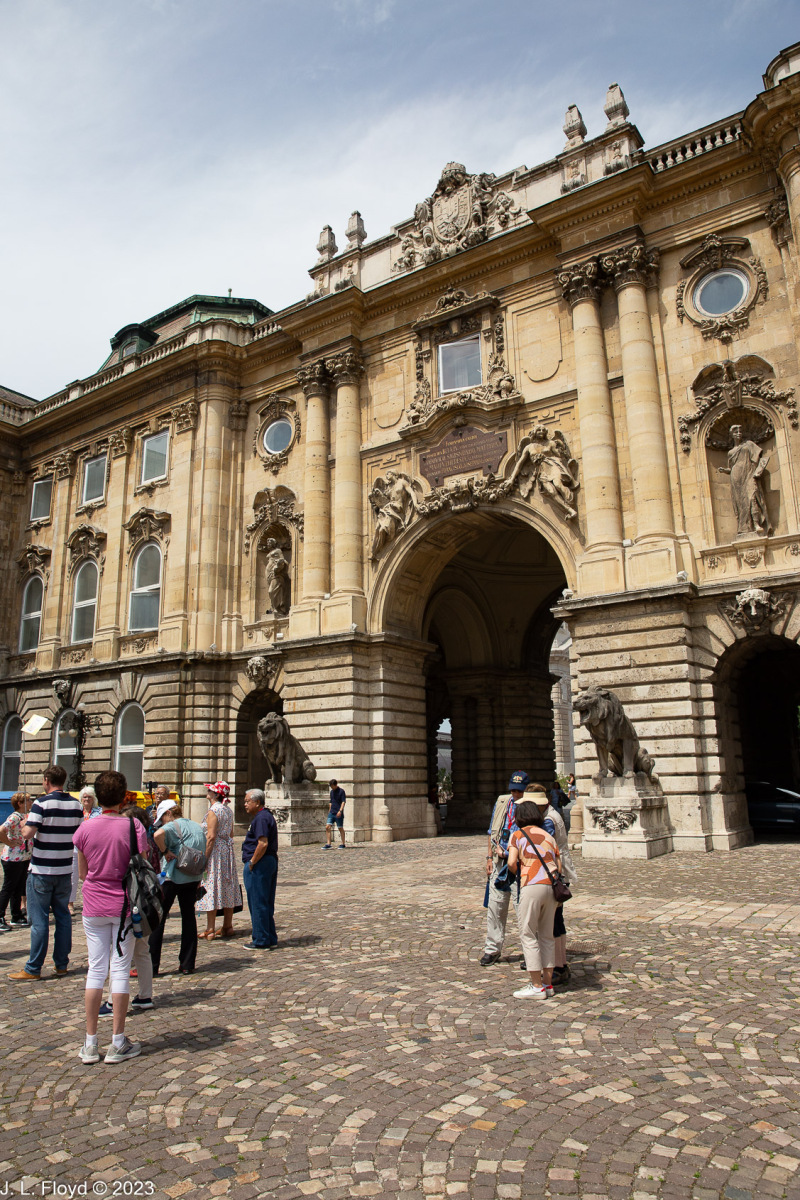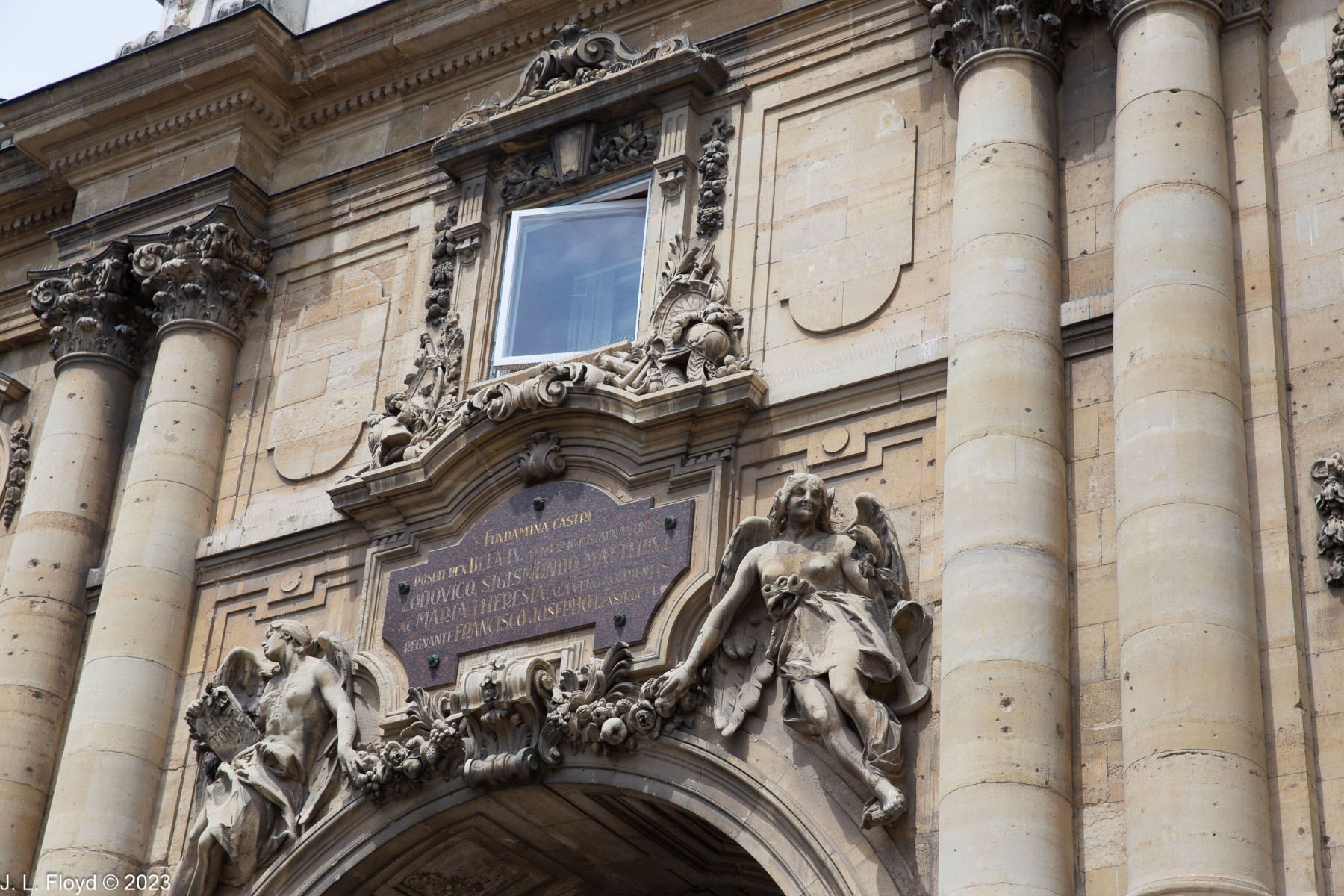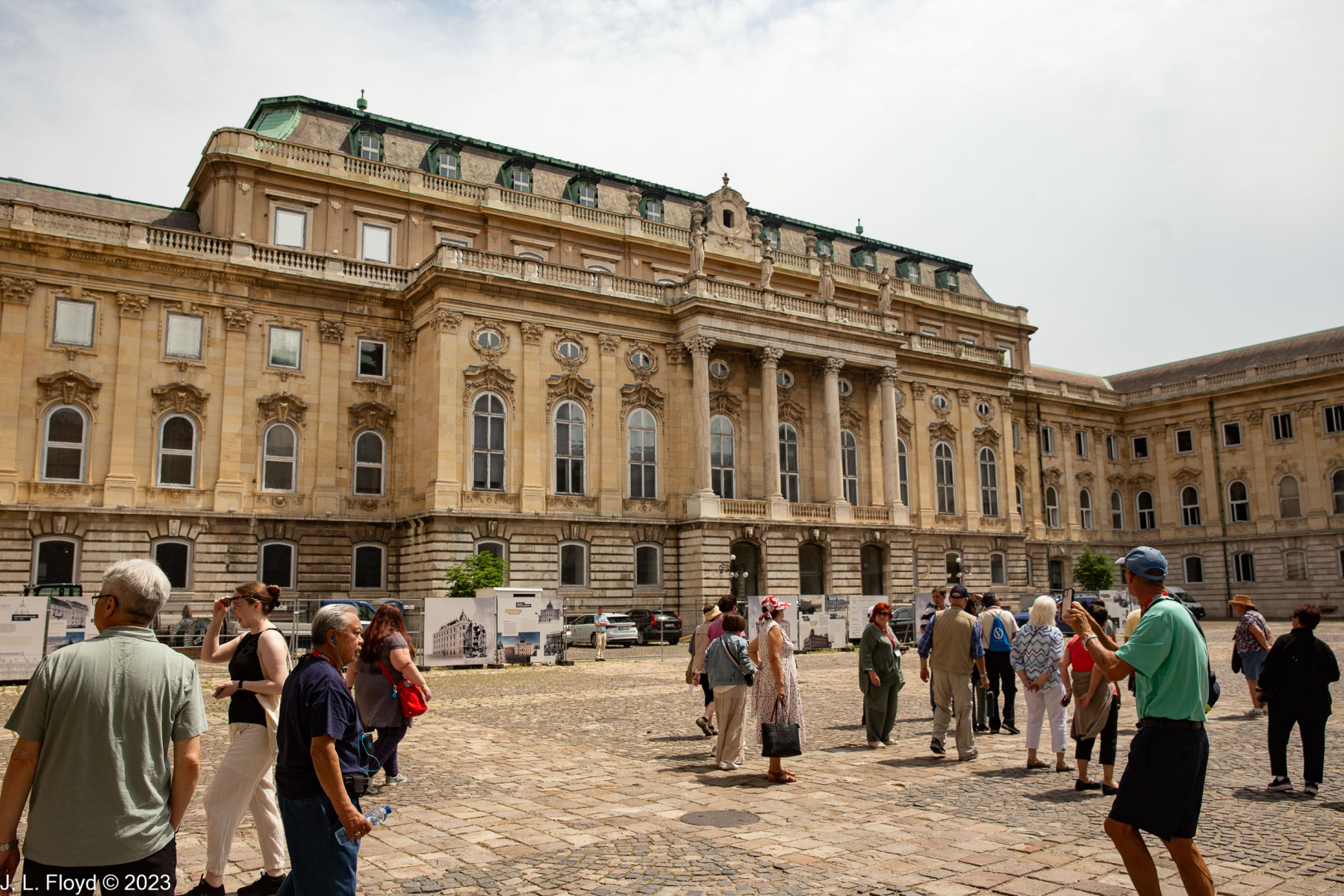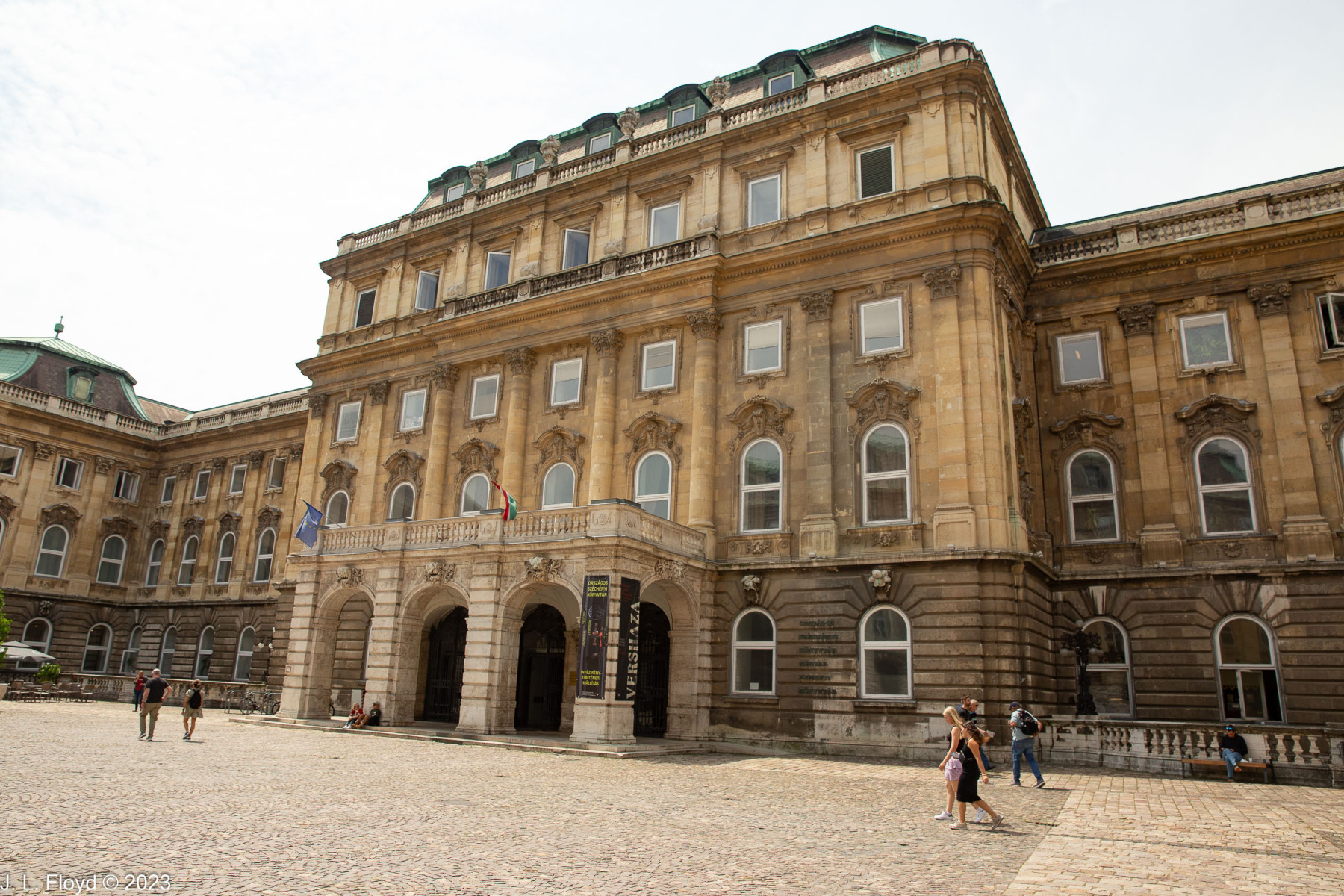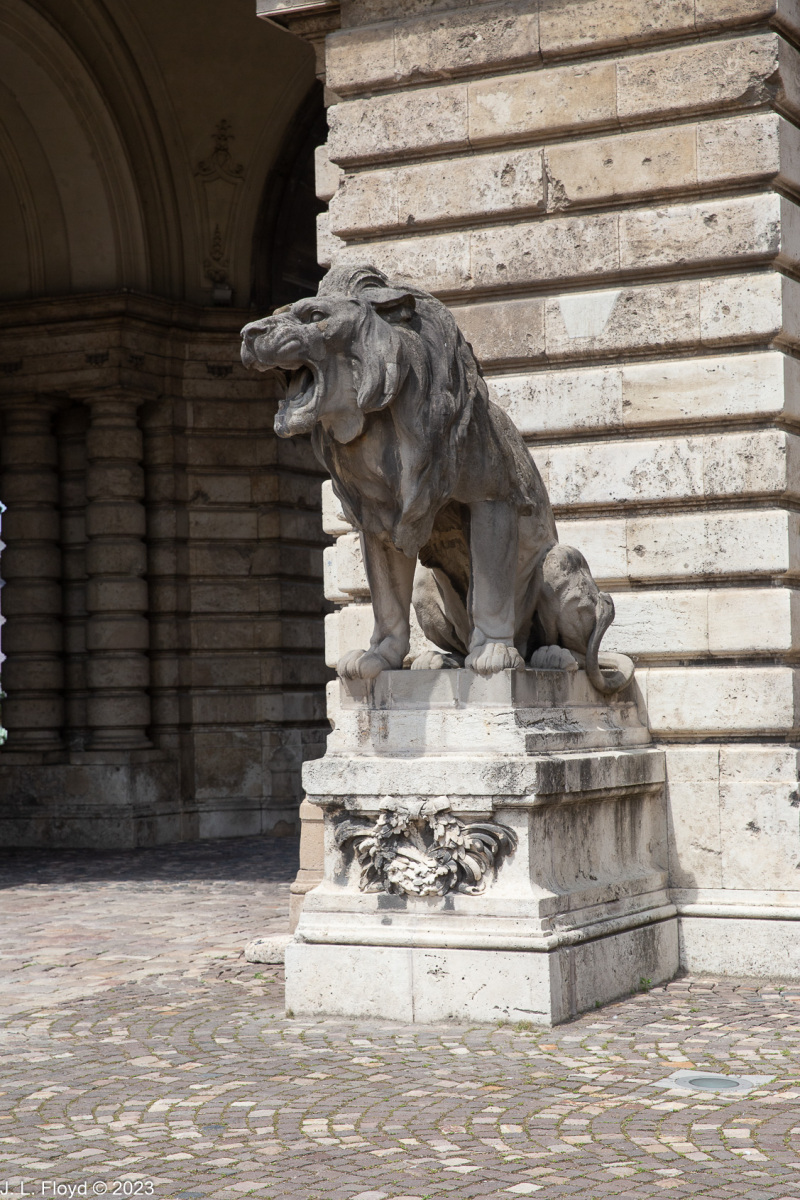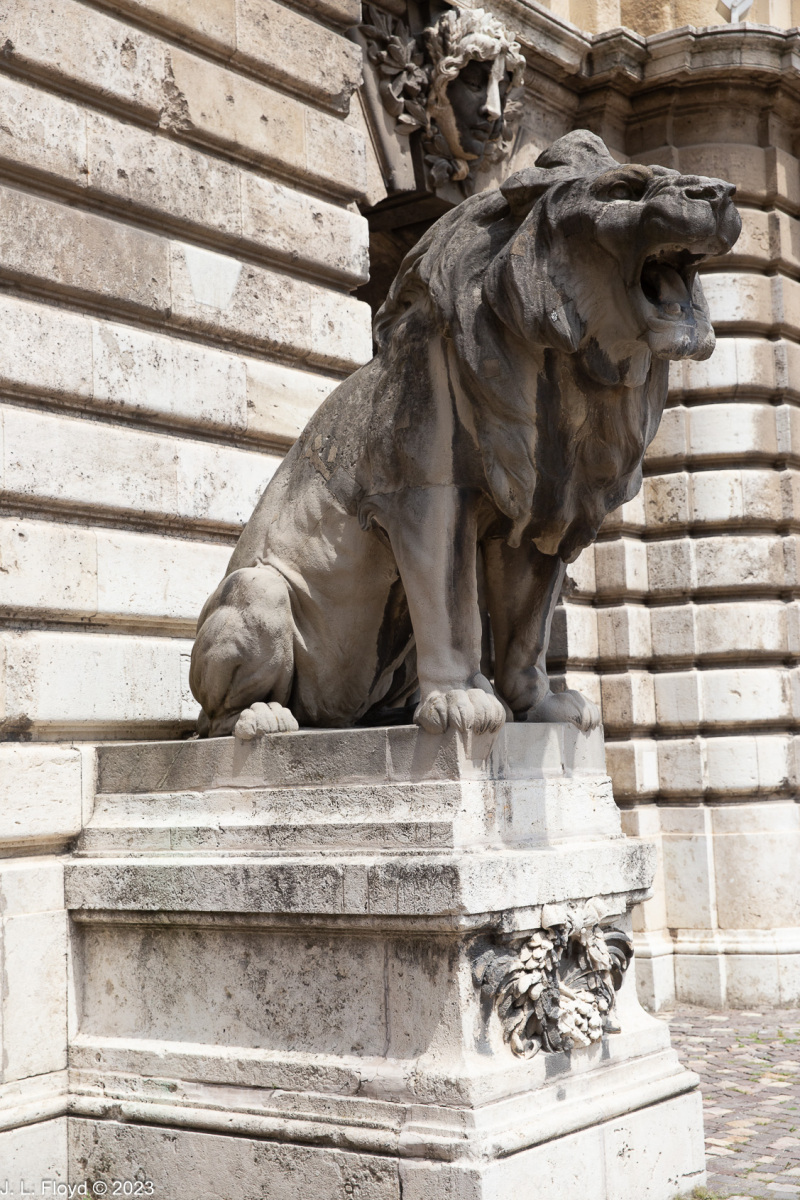Our bus deposited us on Castle Hill near the Statue of the Old Hussar. Hussars originated in Hungary in the fifteenth century; they were a type of light cavalry particularly useful in scouting and raiding, in contrast with dragoons, who were heavy cavalry fighting both mounted and unmounted. This hussar seemed to be contemplating his sword, which he held in his hands, and I wondered whether he was trying to decide which victim to behead next or merely considering whether it was sharp enough to do so.
In contrast to the peaceful and sedate Philosophers’ Garden, Castle Hill was bustling with activity, both of tourism and construction. In 2013 the Hungarian government initiated the “National Hauszmann Program” to restore and revitalize the historic structures of the Castle district, such as the Archduke Joseph’s palace, which was the first structure we encountered. It and several other structures were cordoned off and encased in scaffolding, and several giant cranes presided over them.
Continuing on down St. George Street, we came upon a neo-classical palace built in 1806 by Count Victor Sándor, a Hungarian aristocrat. Since 2003 it has been the residence and office of the President of Hungary (currently Katalin Novák; Victor Orbán is Prime Minister). We were able to witness the changing of the guard there.
At Sándor Palace we made a left turn and came to a large open plaza, elegantly fenced off with iron grillwork on the south side. On a column at the southeast corner of the plaza is perched the statue of a large bird, which looked to me like a vulture, but which is intended to represent the Turul, a mythical falcon-like bird and a national symbol of Hungary. Not far from the Turul is the Habsburg Gate, which opens to the Habsburg Steps, a stone stairway descending to a courtyard below called Fisherman’s Terrace.
Before going any further I should note that although the vast complex I am describing is usually listed in guidebooks as Buda Castle, I prefer to call it Buda Palace because the word “castle” implies a fortification, which it is clearly not. It is a Baroque palace first built in the reign of Empress Maria Theresa during the years 1749 to 1770 to replace the great Hungarian medieval palace, which did deserve to be called a castle but was destroyed in the Turkish wars of the 17th century. The Hungarians call it Budavári Palota, which translates as Buda Palace, and I shall follow suit.
After its initial completion, the Baroque palace underwent many modifications and additions. It was wrecked in the Revolution of 1848 and rebuilt during the rest of the 19th century, under direction of the celebrated Hungarian architects Miklós Ybl (1814-1891) and Alajos Hauszmann (1847-1926). They were responsible for several new additions, and the palace complex reached its “final” form under Hauszmann in 1912.
Finality is rarely final. During the siege of Budapest in World War II, Buda Palace became the last stronghold of the German occupiers against the advance of the Soviet Red Army, and the fighting reduced it to a nearly complete ruin.
Reconstruction efforts began shortly after the war’s end. But the Communist government installed by the Soviets considered Buda Palace to be a symbol of the ancien r
The postwar reconstruction also included efforts to excavate and restore some of the medieval Gothic and Renaissance elements of the complex, but I am unable to distinguish those from the later construction, and to me it’s all Baroque. Art historians, not to mention locals, will undoubtedly find much to criticize in my descriptions, for which I abjectly beg and beseech forgiveness.
The current restoration and reconstruction project, the National Hauszmann Program, aims not only to further restore the Buda Palace complex as far as possible to its pre-World War II state, but also to revive its role as a seat of government. The first part of the program is already partially complete with the rebuilding of the Royal Riding hall, Stöckl Staircase and the Royal Guard headquarters (2019); reconstruction of the Archduke Joseph’s Palace is underway. The transfer of government functions to Castle Hill has also begun with the relocation of the Prime Minister’s offices from the Parliament building to Buda Palace in 2019. The next moves on the agenda are the relocation of the Ministries of Defense and Foreign Affairs to newly rebuilt quarters on the Hill.
The Hauszmann project has evoked a great deal of controversy. Proponents assert that Castle Hill is historically the proper place for government agencies and having them there improves the appearance of the district as well as the country’s image. Critics argue that the ministries are doing fine in their current locations, moving them is extremely costly, and having them on Castle Hill will increase traffic, inconvenience local residents and interfere with the tourist trade.
Descending the Habsburg Steps to the Fisherman’s Terrace, we came to the famous Fountain of the Fishing Children. The Fountain holds a 1912 creation by sculptor Károly Senyei depicting two children trying to catch a fish. Their net is especially notable for its fine workmanship. From the Fisherman’s Terrace, which fronts a side wing of the palace, one continues on to the Savoy Terrace, in front of the main entrance. These terraces provide wonderful views of the city of Budapest. The Savoy Terrace is the location of an equestrian statue of Prince Eugene of Savoy, the great general who decisively defeated the Ottoman Turks in the late 17th century and later partnered with the British Duke of Marlborough in saving the Austrian Empire from French conquest.
Also on Savoy Terrace, on either side of the palace entrance, are statues of Csongor and Tünde, the title characters of a major Hungarian literary work, the fairy-tale poetic play Csongor és Tünde, by Mihály Vörösmarty. I only photographed the statue of Csongor.
From the Savoy Terrace I was able to see and photograph the Hungarian Parliament building on the Pest bank of the Danube to the north; and directly across the river from Castle Hill, the Chain Bridge over the Danube, the Four Seasons Hotel/Gresham Palace, the Ministry of Interior to its right, and St. Stephen’s Basilica.
After soaking up the spectacular views from Savoy Terrace, we went around a corner of the palace to the Hunyadi Court on the west side. There we encountered a magnificent fountain sculpture created in 1900 by Alajos Stróbl. It depicts a hunting party led by King Matthias Corvinus (1443-1490) and is said to be the most photographed item in the castle complex.
On the west side of Hunyadi Court is the Main Guard Building, the former headquarters of the Hungarian Royal Noble Guard, founded in 1760. It now houses the Főőrség (Guard House) Restaurant and Coffeehouse, which is reputed to be mediocre at best.
On the south side of the courtyard there is an archway flanked by two stately and dignified stone lions. This leads to the Lions’ Court, which was an open court until 1896, when it was closed by adding the Krisztinaváros wing of the palace, named after the daughter of Maria Theresa. It now houses the Hungarian National Library.
The inner side of the archway is guarded by two more stone lions, who in contrast to the dignified lions on the other side are menacing, so much that you can almost hear them roaring. This was puzzling to me because I would have expected that the the hostile lions would be positioned on the outside to discourage undesirables, such as Donald Trump, from entering the courtyard, rather on the inside to discourage them from leaving.
On the east side of the Lion’s Court, opposite the Library, is the facade of the Grand Ballroom in the main wing of the palace. The interior of the Ballroom did not survive the destruction of World War II and the post-war remodeling.
The Lions’ Court also contains the Palatinal Crypt, which we did not see because it is underground. The entrance is presumably in the National Library. The Crypt is the burial place of the palatinal branch of the Habsburg family, i.e. the Hapsburgs who actually resided in Budapest. The Austrian emperors normally lived in Vienna and made only occasional visits to Budapest, but they sent their junior members – usually brothers of the monarch – to govern the unruly Hungarians. From 1796 to 1847 that was Archduke Joseph Anton, younger brother of Austrian Emperor Francis I. It was he who established the crypt as the family mausoleum for the Hungarian palatinal branch of the Habsburgs. Ironically, this place of death was the only part of the Buda Palace to survive intact the ravages of World War II.
Exiting the Lions’ Court, we backtracked through Hunyadi Court and left the palace grounds by way of Beggars’ Gate, as it had been known in medieval times. We encountered no beggars, but we did pass an iron spiderweb gate grille presided over by the figure of a raven with a ring in its beak. This is a symbol of the Hunyadi family, and is especially associated with King Matthias, on whose family crest and coat of arms it appears.
